Research on Obesity in Australia: Distribution, Causes, and Effects
VerifiedAdded on 2023/06/09
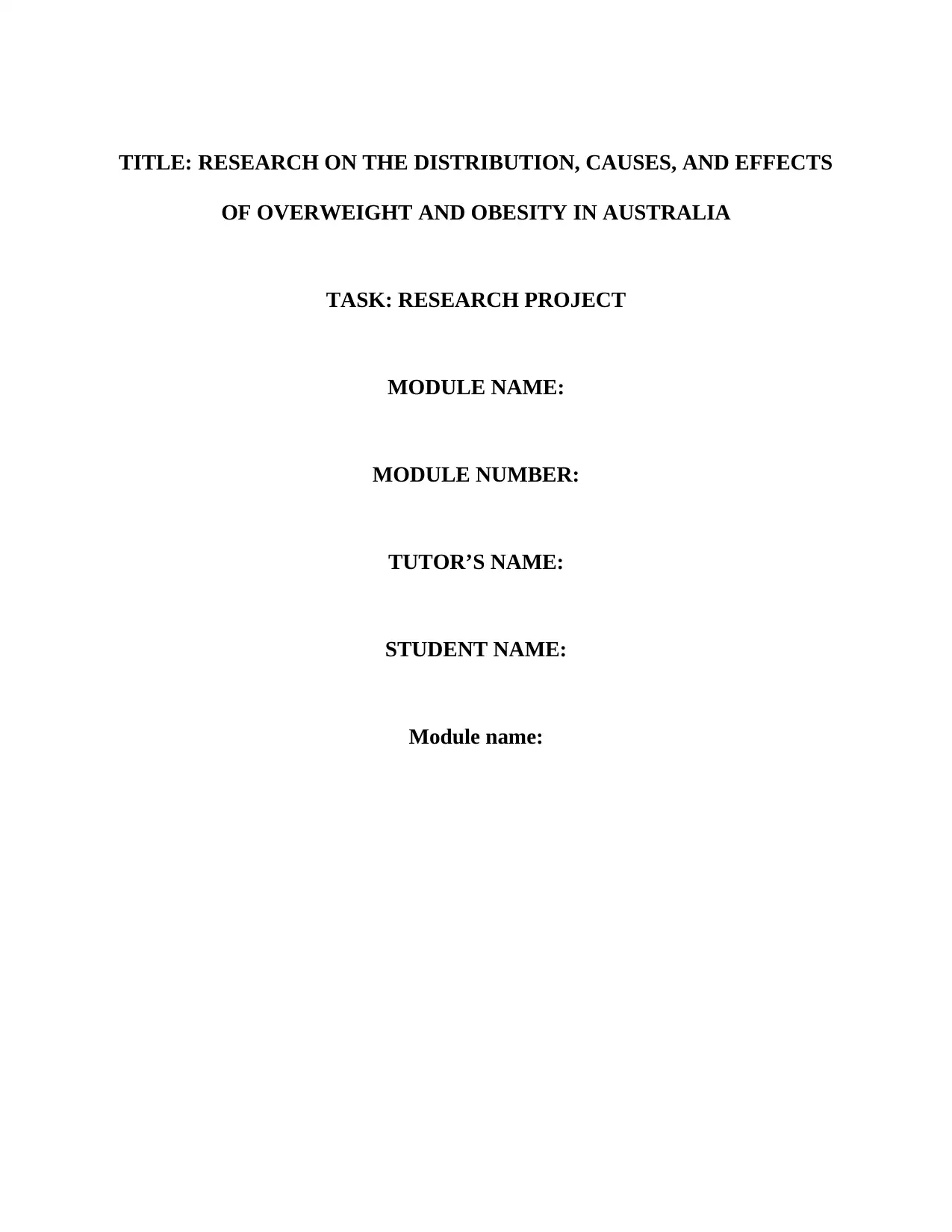
OF OVERWEIGHT AND OBESITY IN AUSTRALIA
TASK: RESEARCH PROJECT
MODULE NAME:
MODULE NUMBER:
TUTOR’S NAME:
STUDENT NAME:
Module name:
Paraphrase This Document
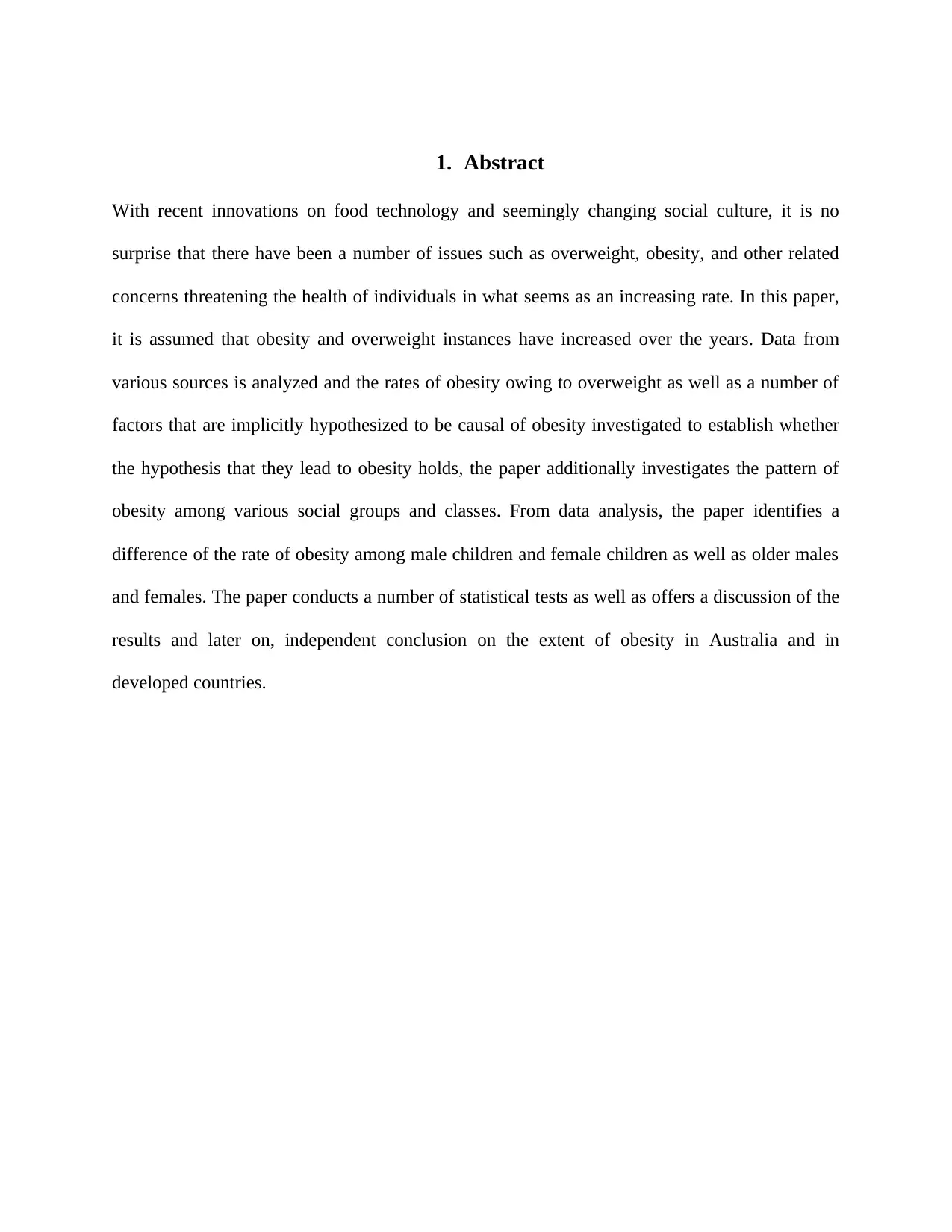
With recent innovations on food technology and seemingly changing social culture, it is no
surprise that there have been a number of issues such as overweight, obesity, and other related
concerns threatening the health of individuals in what seems as an increasing rate. In this paper,
it is assumed that obesity and overweight instances have increased over the years. Data from
various sources is analyzed and the rates of obesity owing to overweight as well as a number of
factors that are implicitly hypothesized to be causal of obesity investigated to establish whether
the hypothesis that they lead to obesity holds, the paper additionally investigates the pattern of
obesity among various social groups and classes. From data analysis, the paper identifies a
difference of the rate of obesity among male children and female children as well as older males
and females. The paper conducts a number of statistical tests as well as offers a discussion of the
results and later on, independent conclusion on the extent of obesity in Australia and in
developed countries.
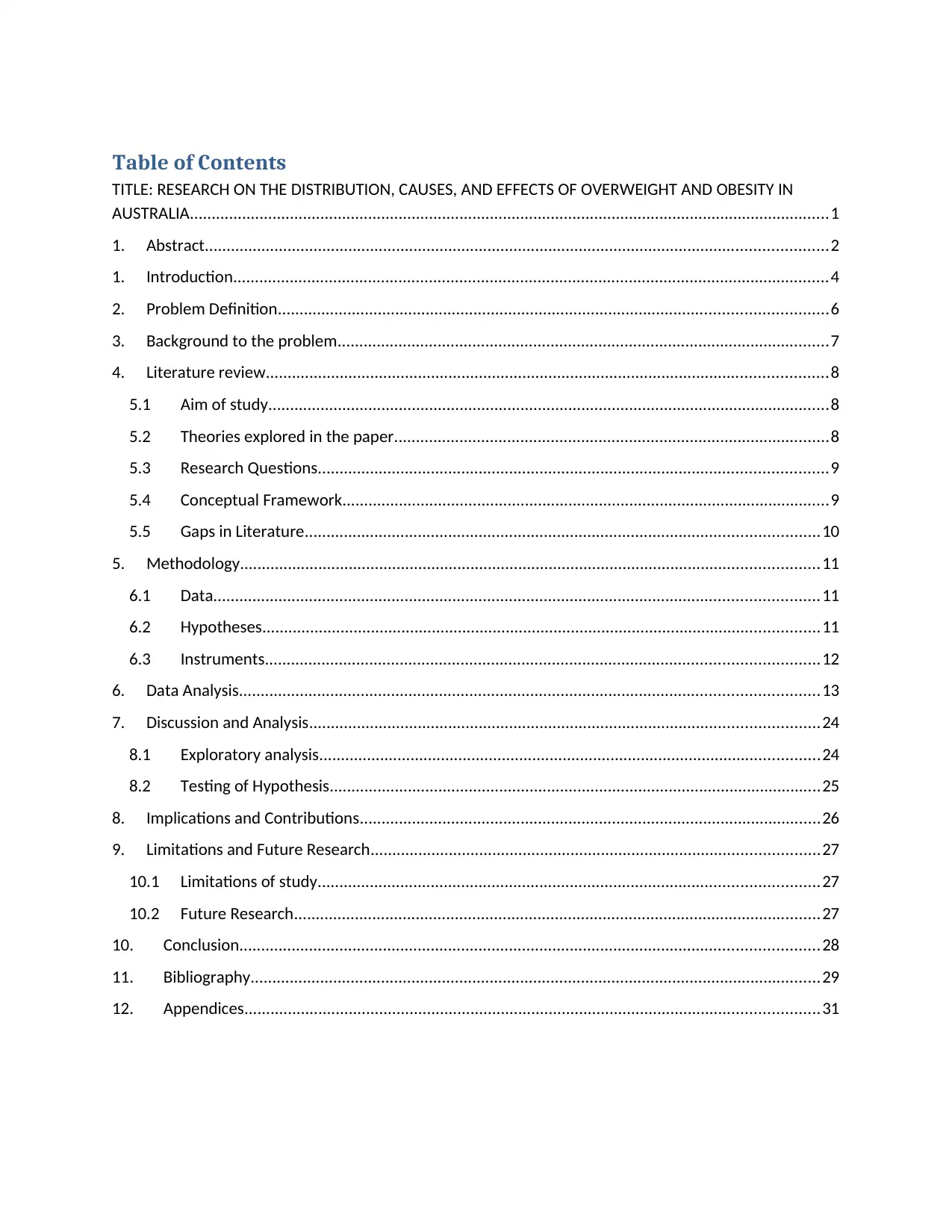
TITLE: RESEARCH ON THE DISTRIBUTION, CAUSES, AND EFFECTS OF OVERWEIGHT AND OBESITY IN
AUSTRALIA...................................................................................................................................................1
1. Abstract...............................................................................................................................................2
1. Introduction.........................................................................................................................................4
2. Problem Definition..............................................................................................................................6
3. Background to the problem.................................................................................................................7
4. Literature review.................................................................................................................................8
5.1 Aim of study.................................................................................................................................8
5.2 Theories explored in the paper....................................................................................................8
5.3 Research Questions.....................................................................................................................9
5.4 Conceptual Framework................................................................................................................9
5.5 Gaps in Literature......................................................................................................................10
5. Methodology.....................................................................................................................................11
6.1 Data...........................................................................................................................................11
6.2 Hypotheses................................................................................................................................11
6.3 Instruments...............................................................................................................................12
6. Data Analysis.....................................................................................................................................13
7. Discussion and Analysis.....................................................................................................................24
8.1 Exploratory analysis...................................................................................................................24
8.2 Testing of Hypothesis.................................................................................................................25
8. Implications and Contributions..........................................................................................................26
9. Limitations and Future Research.......................................................................................................27
10.1 Limitations of study...................................................................................................................27
10.2 Future Research.........................................................................................................................27
10. Conclusion.....................................................................................................................................28
11. Bibliography...................................................................................................................................29
12. Appendices....................................................................................................................................31
⊘ This is a preview!⊘
Do you want full access?
Subscribe today to unlock all pages.

Trusted by 1+ million students worldwide
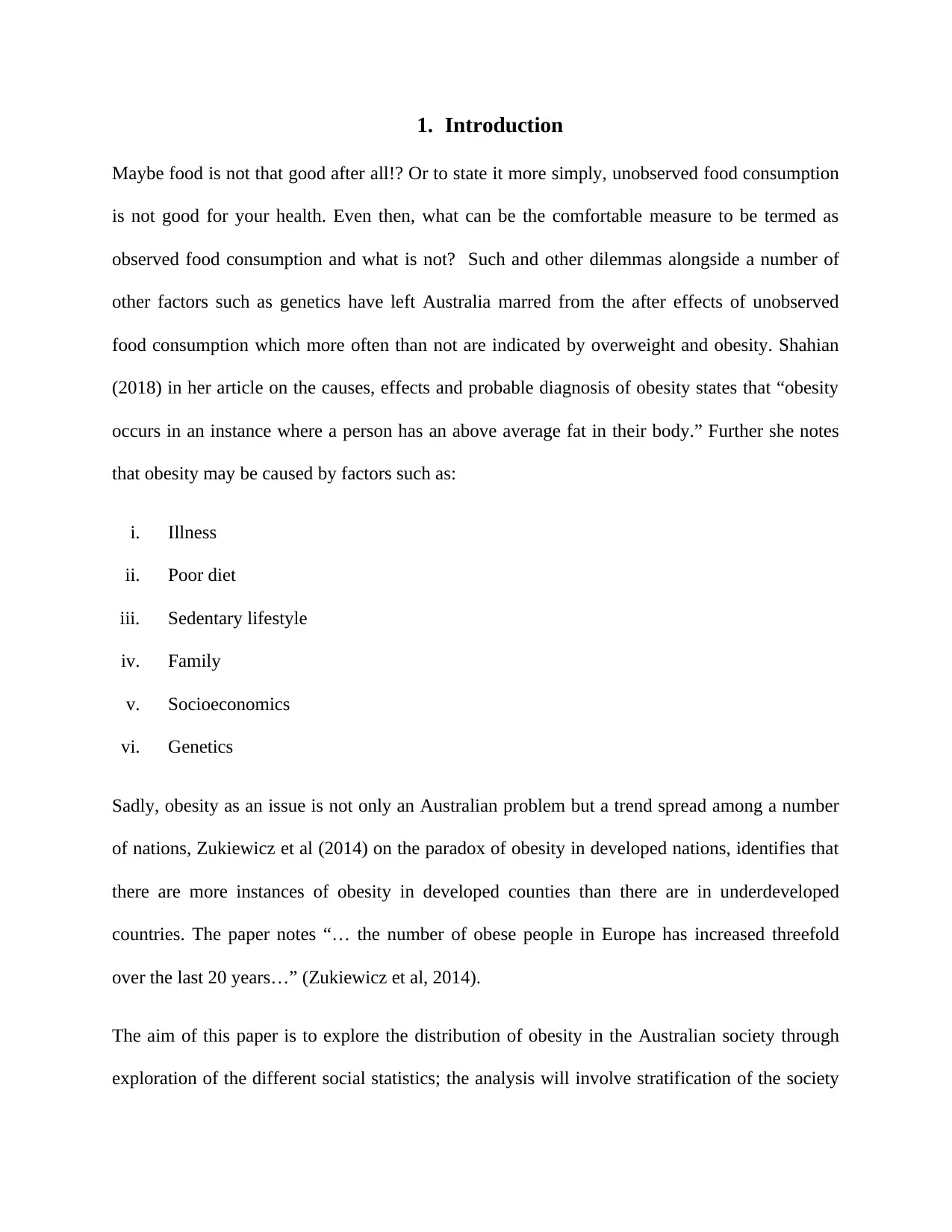
Maybe food is not that good after all!? Or to state it more simply, unobserved food consumption
is not good for your health. Even then, what can be the comfortable measure to be termed as
observed food consumption and what is not? Such and other dilemmas alongside a number of
other factors such as genetics have left Australia marred from the after effects of unobserved
food consumption which more often than not are indicated by overweight and obesity. Shahian
(2018) in her article on the causes, effects and probable diagnosis of obesity states that “obesity
occurs in an instance where a person has an above average fat in their body.” Further she notes
that obesity may be caused by factors such as:
i. Illness
ii. Poor diet
iii. Sedentary lifestyle
iv. Family
v. Socioeconomics
vi. Genetics
Sadly, obesity as an issue is not only an Australian problem but a trend spread among a number
of nations, Zukiewicz et al (2014) on the paradox of obesity in developed nations, identifies that
there are more instances of obesity in developed counties than there are in underdeveloped
countries. The paper notes “… the number of obese people in Europe has increased threefold
over the last 20 years…” (Zukiewicz et al, 2014).
The aim of this paper is to explore the distribution of obesity in the Australian society through
exploration of the different social statistics; the analysis will involve stratification of the society
Paraphrase This Document
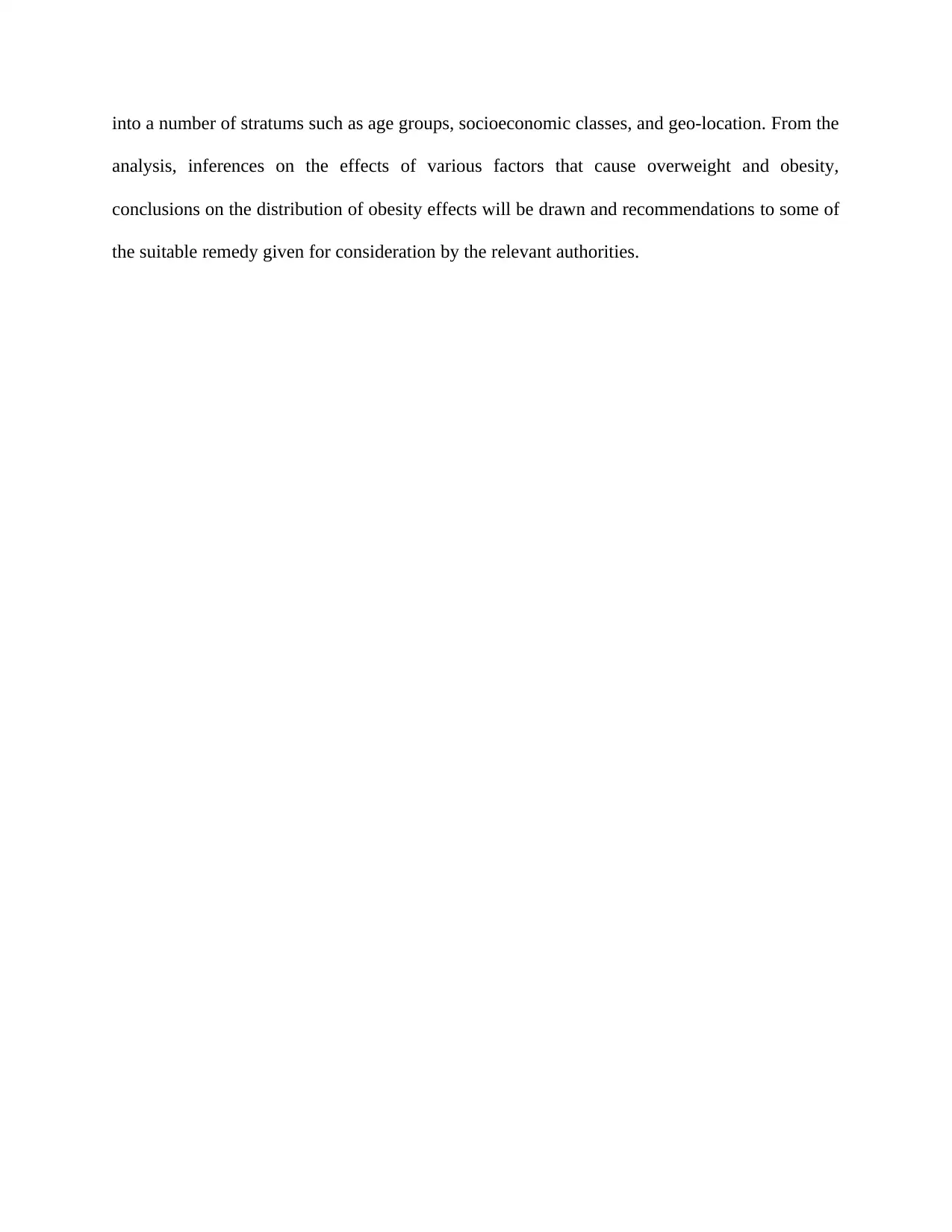
analysis, inferences on the effects of various factors that cause overweight and obesity,
conclusions on the distribution of obesity effects will be drawn and recommendations to some of
the suitable remedy given for consideration by the relevant authorities.

The research’s main concern is to explore the distribution of obesity and overweight majorly in
the Australian society as well as examine how Australia performs in the wider image of
developed countries. The paper also explores what would be the causes of obesity and
overweight. It aims at establishing a pattern between the obesity rates among different social
strata through data analysis and inference to previous studies. Following the analysis and
discussion, the paper should be able to offer effective guidelines to possible remedies and
preventive measures for overweight and obesity.
⊘ This is a preview!⊘
Do you want full access?
Subscribe today to unlock all pages.

Trusted by 1+ million students worldwide
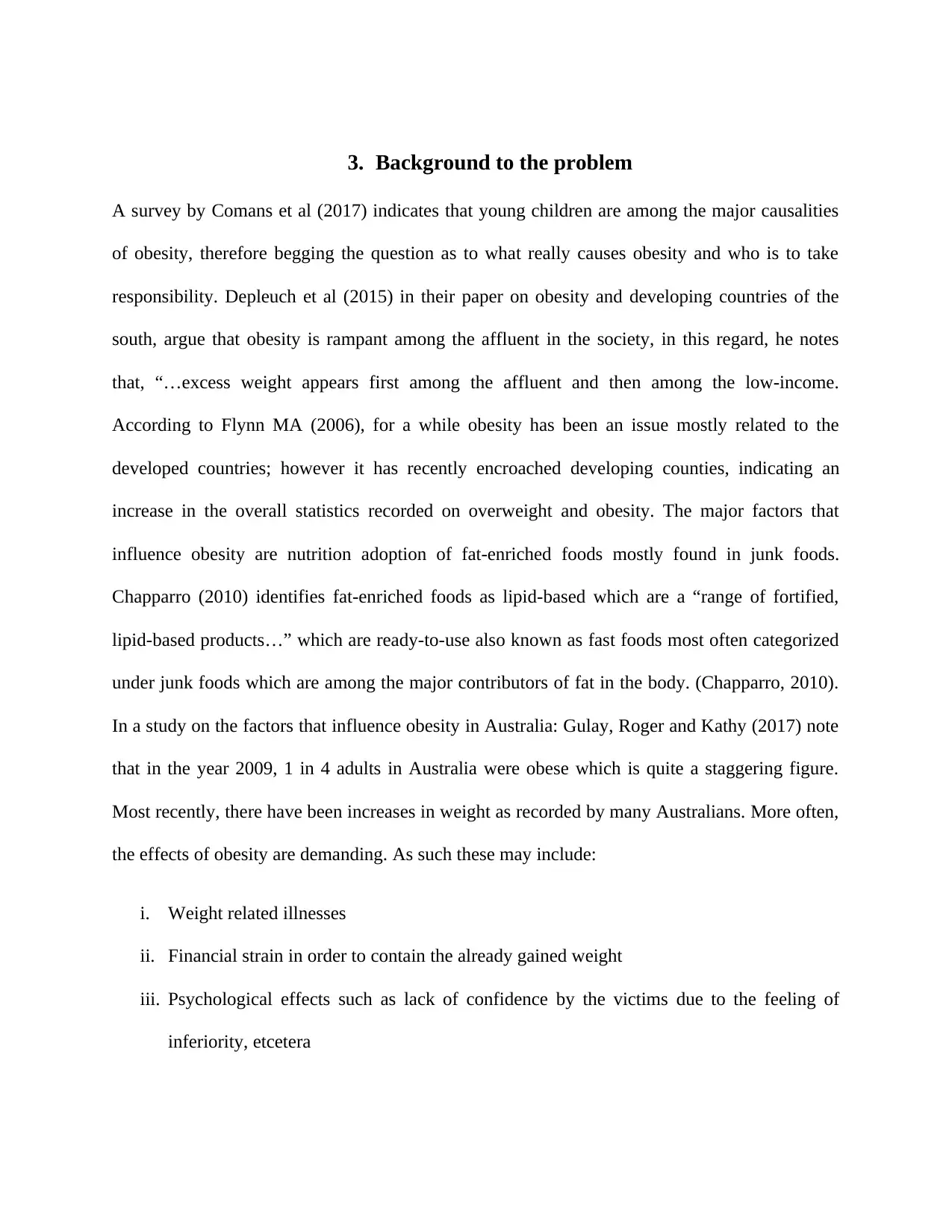
A survey by Comans et al (2017) indicates that young children are among the major causalities
of obesity, therefore begging the question as to what really causes obesity and who is to take
responsibility. Depleuch et al (2015) in their paper on obesity and developing countries of the
south, argue that obesity is rampant among the affluent in the society, in this regard, he notes
that, “…excess weight appears first among the affluent and then among the low-income.
According to Flynn MA (2006), for a while obesity has been an issue mostly related to the
developed countries; however it has recently encroached developing counties, indicating an
increase in the overall statistics recorded on overweight and obesity. The major factors that
influence obesity are nutrition adoption of fat-enriched foods mostly found in junk foods.
Chapparro (2010) identifies fat-enriched foods as lipid-based which are a “range of fortified,
lipid-based products…” which are ready-to-use also known as fast foods most often categorized
under junk foods which are among the major contributors of fat in the body. (Chapparro, 2010).
In a study on the factors that influence obesity in Australia: Gulay, Roger and Kathy (2017) note
that in the year 2009, 1 in 4 adults in Australia were obese which is quite a staggering figure.
Most recently, there have been increases in weight as recorded by many Australians. More often,
the effects of obesity are demanding. As such these may include:
i. Weight related illnesses
ii. Financial strain in order to contain the already gained weight
iii. Psychological effects such as lack of confidence by the victims due to the feeling of
inferiority, etcetera
Paraphrase This Document

5.1 Aim of study
The main aim of this study is to explore the effects obesity, the causes of obesity, the distribution
of obesity in Australia as well as the rest of the world. Additionally, the paper aims at examining
the growth rate of obesity over the past years and comment on the pattern
5.2 Theories explored in the paper
There are a number of factors put forward as causes of obesity
1) Theory one: Inferior dietary routines
As noted earlier on, unobserved dietary consumption is one of the major factors that cause
obesity. Some of the reasons for such dietary patterns may comprise: Most of the young
Australia generation is addicted to the low cost street and unhealthy food, additionally busy
schedules which deprive a majority of the individuals’ ample time to cook healthy meals and
therefore resort to junk foods.
2) Theory two: Genetics
A paper by Ulaval (2018) indicate that there are various types of obesity that concentrate in a
family, as such, the chance of a person from a line of family with a history of obesity to be obese
are relatively higher than that of a person from a non-obese history. Studies indicate that genes
are susceptible to solely lead to obesity. Such disorders include the Bardet-Biedl and Prader-
WIlli syndromes. Nevertheless, it is not always that genes may lead to health complications; in
the case of obesity it is often a combination of both genes and behavior that cause genes to be
included as a causal agent of obesity.

Researches done by Pampel et al. (2012) suggest that, “The higher the nation’s economic
development, the higher the shift in the obesity rates…”
4) Theory four: Level of physical activities
Pampel (2012) argues that “…activities such as reading, attending cultural events, and going to
the movies…” are effectual in lowering the BMI (Body Mass Weight) just the same as exercise.
Whereas, passive activities like watching television or movies had no effect on lowering the
BMI.
5.3 Research Questions
To enable focus of the researcher on the specific objectives of the research, the following
research questions are used:
i. What are the factors that are likely to cause overweight and obesity?
ii. Does overweight indicate a path to obesity i.e. does overweight act as a preliminary stage
to obesity or are they disjoint?
iii. Is there a difference in the Australian population strata of persons with instances of
overweight and obesity?
⊘ This is a preview!⊘
Do you want full access?
Subscribe today to unlock all pages.

Trusted by 1+ million students worldwide
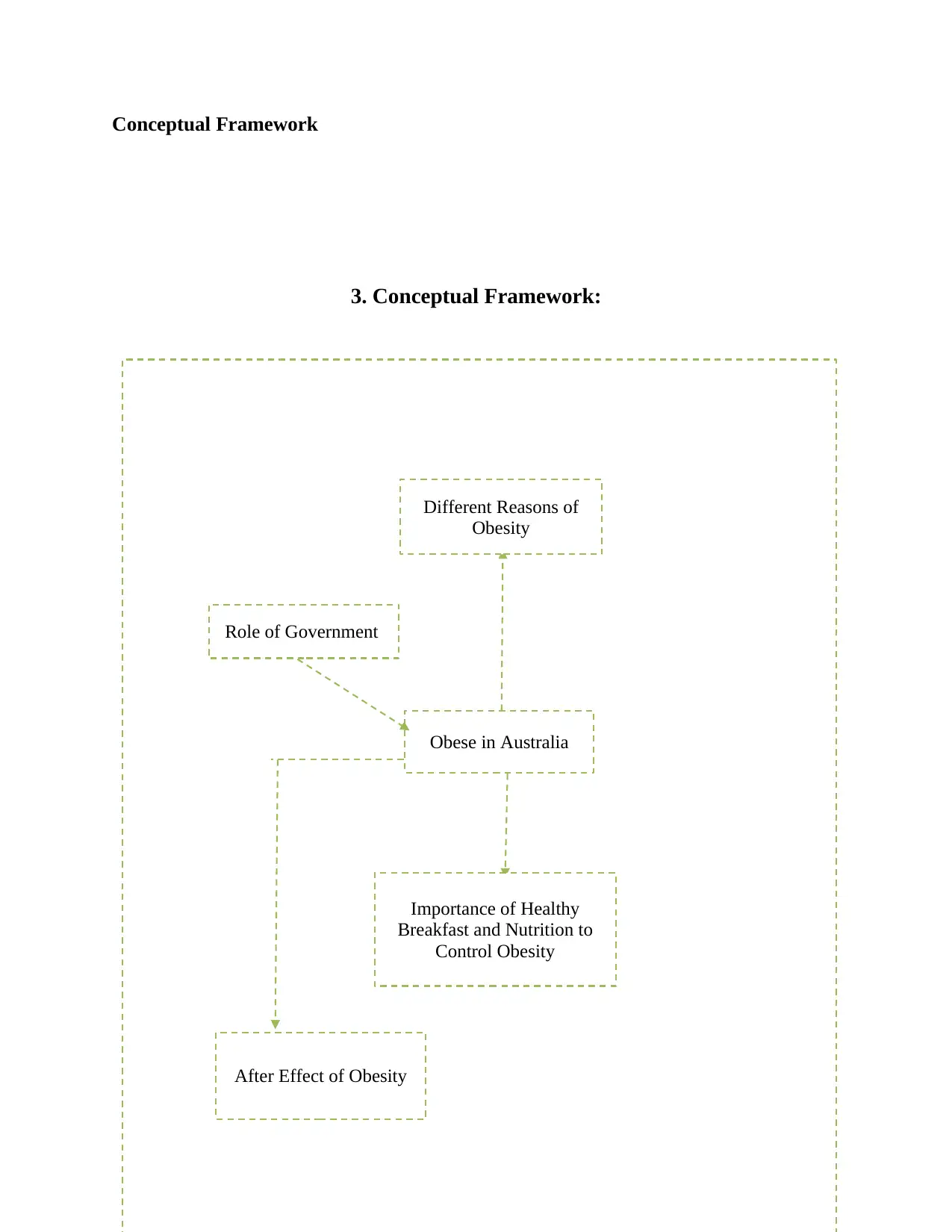
Different Reasons of
Obesity
Importance of Healthy
Breakfast and Nutrition to
Control Obesity
Role of Government
After Effect of Obesity
Conceptual Framework
3. Conceptual Framework:
Paraphrase This Document

Previous studies have expressed different views and projections of the situation of obesity and
overweight in Australia. Sadly, there have not been enough social groups out to take the
responsibility of ensuring reduction of the rates obesity despite exposure of the pending epidemic
by both researchers and scholars. In a study by Moretto and Byrnes (2017) on the role of
government on the fight against obesity in their paper about “Public Preferences for the Use of
Taxation and Labeling Policy Measures to Combat Obesity in Young Children in Australia,”
they debate that the government is interested on initiatives of launching taxation policy however
from the recent survey it is noted that taxation policy has not make a great impact over street
food addiction of young generation. Comans et al. (2017) argue that unless the young generation
reconsider their take on unhealthy foods the issue of obesity is likely to stay for a while. The
previous researches do not highlight the underlying events that may lead to addiction of junk
foods but only concentrate on the ultimate addiction. Therefore, making leaps past the root
causes of unhealthy food observances into conclusions of the effect of such unhealthy food
observances, therefore creating a gap.

6.1 Data
The secondary data for this project was obtained from the Australian health department database
for the years 1995 to 2015. It is divided into various data-sets according to categories which
include (Region- urban and rural, Age - young and old, Australian cities, Adults (1995-2015).
Whereas, the primary data is obtained from sample surveys filled by members of different
Australian strata groups.
In order to examine the research questions, two sets of hypotheses are formulated to help in the
process of establishing the rate of obese and overweight in Australia and how it is related to
various factors such as:
i. Age
ii. Place of residence
iii. Rural areas / Urban areas
6.2 Hypotheses
To explore the difference of obesity rates between different Australian cities, the hypotheses to
determine the statistical difference are:
Null hypothesis
H0: Factors such as overweight lead to obesity in both children and adults
Alternative
⊘ This is a preview!⊘
Do you want full access?
Subscribe today to unlock all pages.

Trusted by 1+ million students worldwide

i.e. obesity and overweight do not correlate children grow into obese adults.
To test the difference of obesity between urban and rural areas, the hypothesis includes:
Null hypothesis
H0: There is more obesity in urban centers than in rural areas
Alternative
H1: There is no statistical difference between the obesity rates of urban and rural areas
6.3 Instruments
The data analysis tool for the study was the SPSS software, while the data collection of
secondary sources was from the ministry of health databases through the internet.
Paraphrase This Document
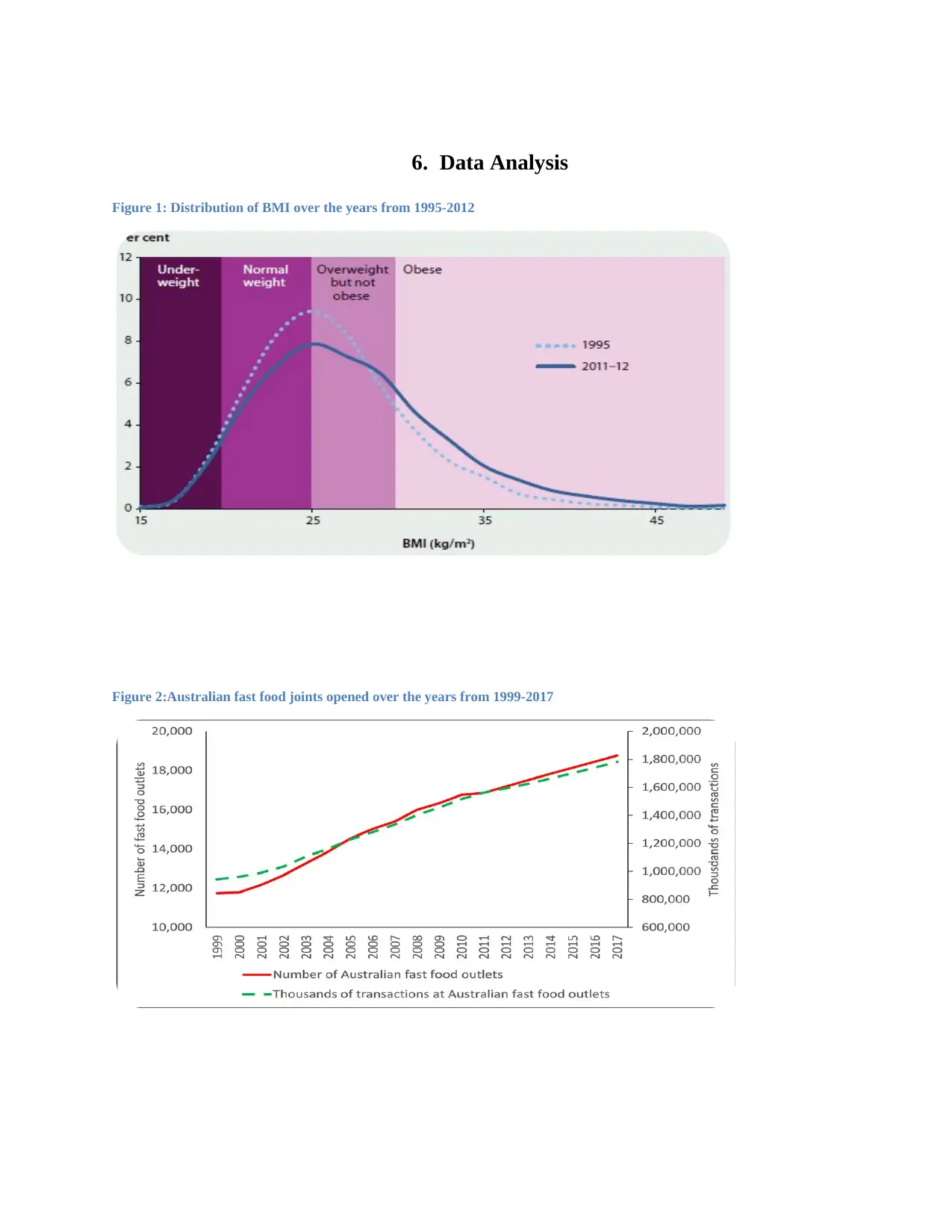
Figure 1: Distribution of BMI over the years from 1995-2012
Figure 2:Australian fast food joints opened over the years from 1999-2017
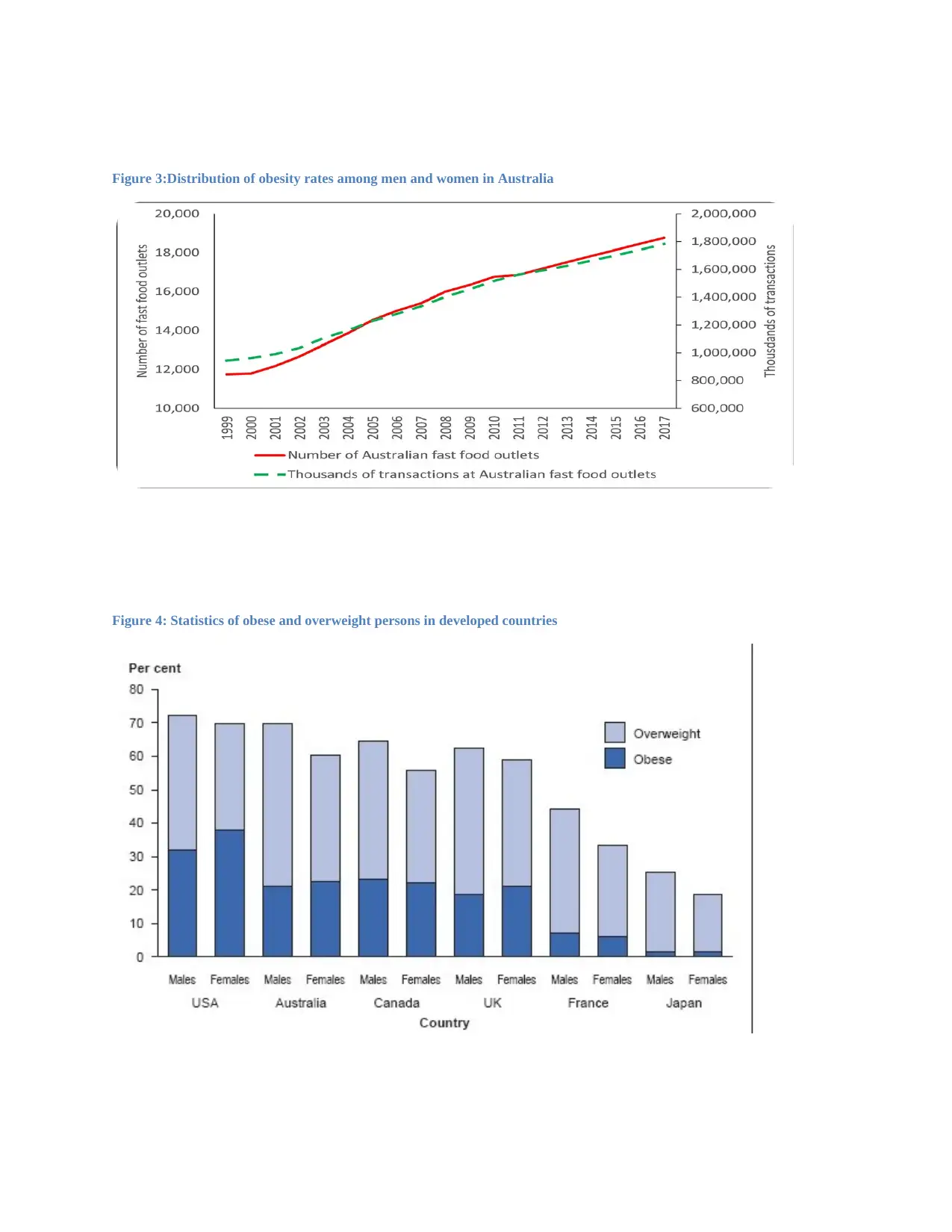
Figure 4: Statistics of obese and overweight persons in developed countries
⊘ This is a preview!⊘
Do you want full access?
Subscribe today to unlock all pages.

Trusted by 1+ million students worldwide
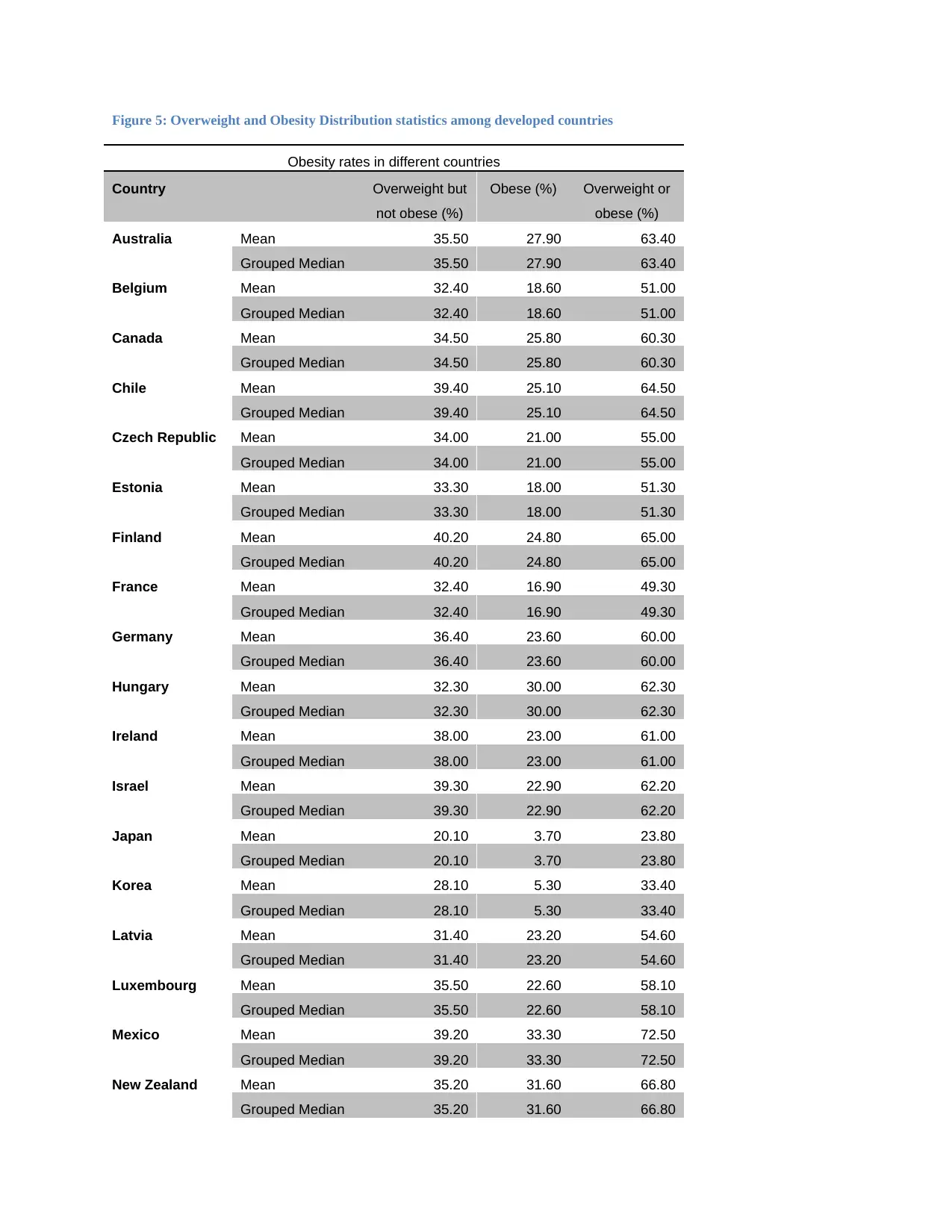
Obesity rates in different countries
Country Overweight but
not obese (%)
Obese (%) Overweight or
obese (%)
Australia Mean 35.50 27.90 63.40
Grouped Median 35.50 27.90 63.40
Belgium Mean 32.40 18.60 51.00
Grouped Median 32.40 18.60 51.00
Canada Mean 34.50 25.80 60.30
Grouped Median 34.50 25.80 60.30
Chile Mean 39.40 25.10 64.50
Grouped Median 39.40 25.10 64.50
Czech Republic Mean 34.00 21.00 55.00
Grouped Median 34.00 21.00 55.00
Estonia Mean 33.30 18.00 51.30
Grouped Median 33.30 18.00 51.30
Finland Mean 40.20 24.80 65.00
Grouped Median 40.20 24.80 65.00
France Mean 32.40 16.90 49.30
Grouped Median 32.40 16.90 49.30
Germany Mean 36.40 23.60 60.00
Grouped Median 36.40 23.60 60.00
Hungary Mean 32.30 30.00 62.30
Grouped Median 32.30 30.00 62.30
Ireland Mean 38.00 23.00 61.00
Grouped Median 38.00 23.00 61.00
Israel Mean 39.30 22.90 62.20
Grouped Median 39.30 22.90 62.20
Japan Mean 20.10 3.70 23.80
Grouped Median 20.10 3.70 23.80
Korea Mean 28.10 5.30 33.40
Grouped Median 28.10 5.30 33.40
Latvia Mean 31.40 23.20 54.60
Grouped Median 31.40 23.20 54.60
Luxembourg Mean 35.50 22.60 58.10
Grouped Median 35.50 22.60 58.10
Mexico Mean 39.20 33.30 72.50
Grouped Median 39.20 33.30 72.50
New Zealand Mean 35.20 31.60 66.80
Grouped Median 35.20 31.60 66.80
Paraphrase This Document
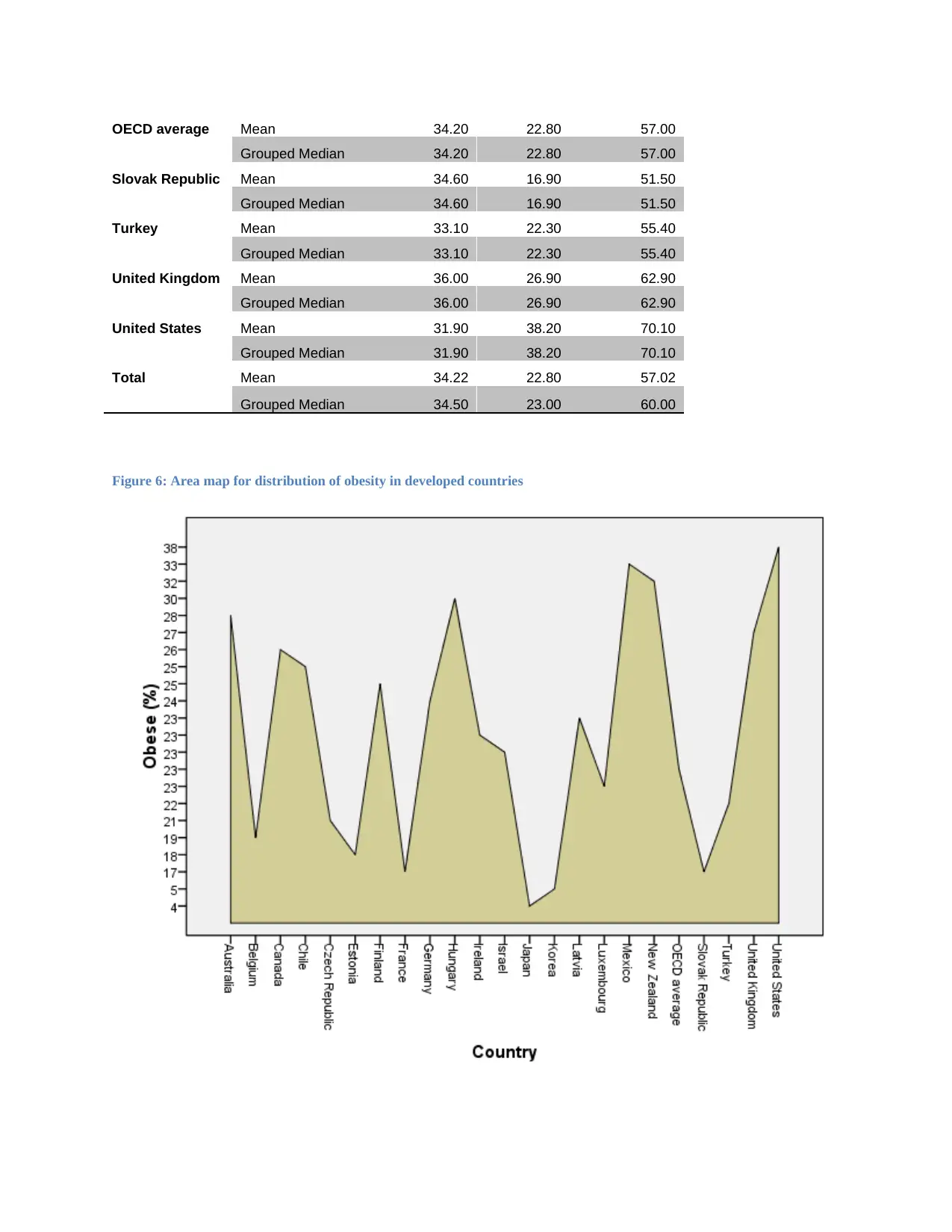
Grouped Median 34.20 22.80 57.00
Slovak Republic Mean 34.60 16.90 51.50
Grouped Median 34.60 16.90 51.50
Turkey Mean 33.10 22.30 55.40
Grouped Median 33.10 22.30 55.40
United Kingdom Mean 36.00 26.90 62.90
Grouped Median 36.00 26.90 62.90
United States Mean 31.90 38.20 70.10
Grouped Median 31.90 38.20 70.10
Total Mean 34.22 22.80 57.02
Grouped Median 34.50 23.00 60.00
Figure 6: Area map for distribution of obesity in developed countries
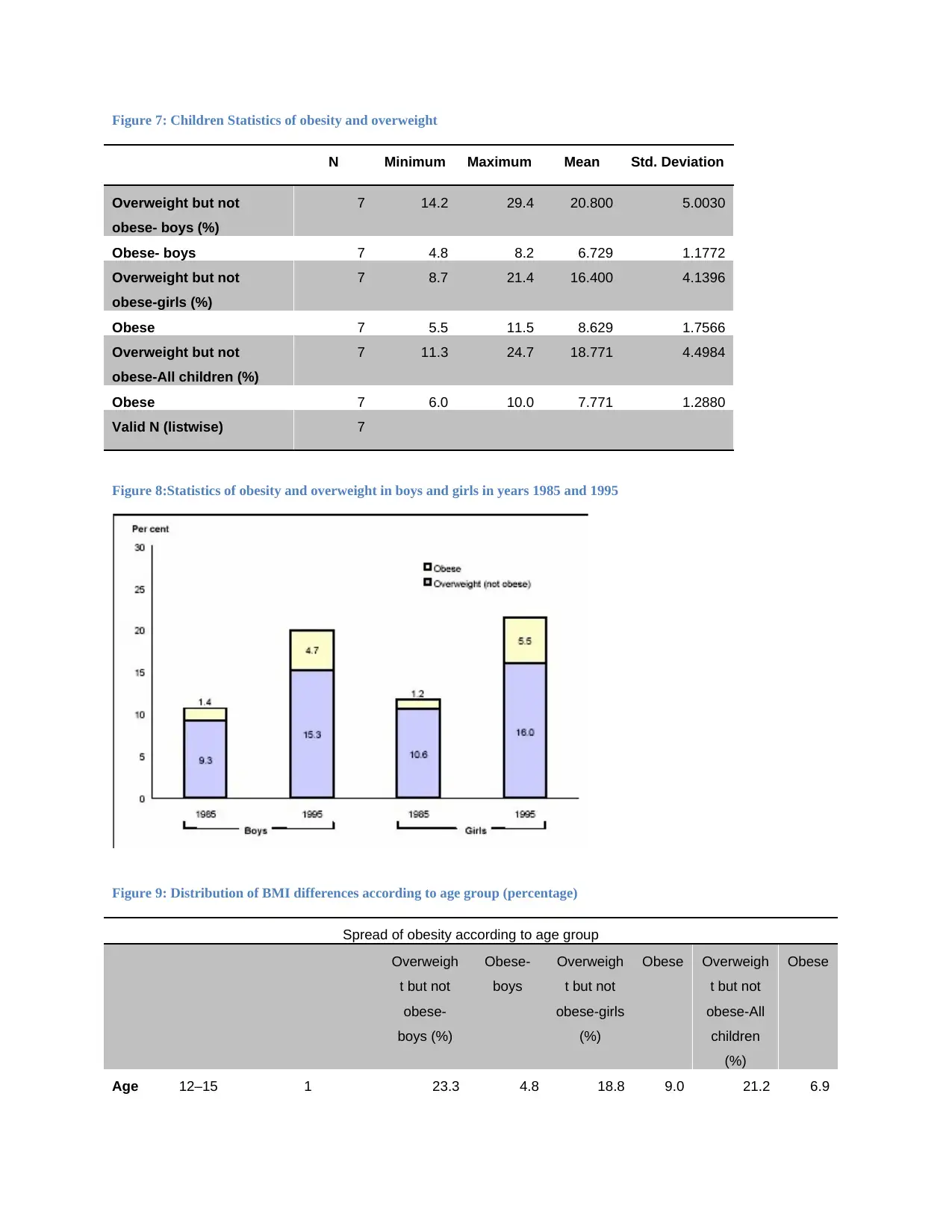
N Minimum Maximum Mean Std. Deviation
Overweight but not
obese- boys (%)
7 14.2 29.4 20.800 5.0030
Obese- boys 7 4.8 8.2 6.729 1.1772
Overweight but not
obese-girls (%)
7 8.7 21.4 16.400 4.1396
Obese 7 5.5 11.5 8.629 1.7566
Overweight but not
obese-All children (%)
7 11.3 24.7 18.771 4.4984
Obese 7 6.0 10.0 7.771 1.2880
Valid N (listwise) 7
Figure 8:Statistics of obesity and overweight in boys and girls in years 1985 and 1995
Figure 9: Distribution of BMI differences according to age group (percentage)
Spread of obesity according to age group
Overweigh
t but not
obese-
boys (%)
Obese-
boys
Overweigh
t but not
obese-girls
(%)
Obese Overweigh
t but not
obese-All
children
(%)
Obese
Age 12–15 1 23.3 4.8 18.8 9.0 21.2 6.9
⊘ This is a preview!⊘
Do you want full access?
Subscribe today to unlock all pages.

Trusted by 1+ million students worldwide
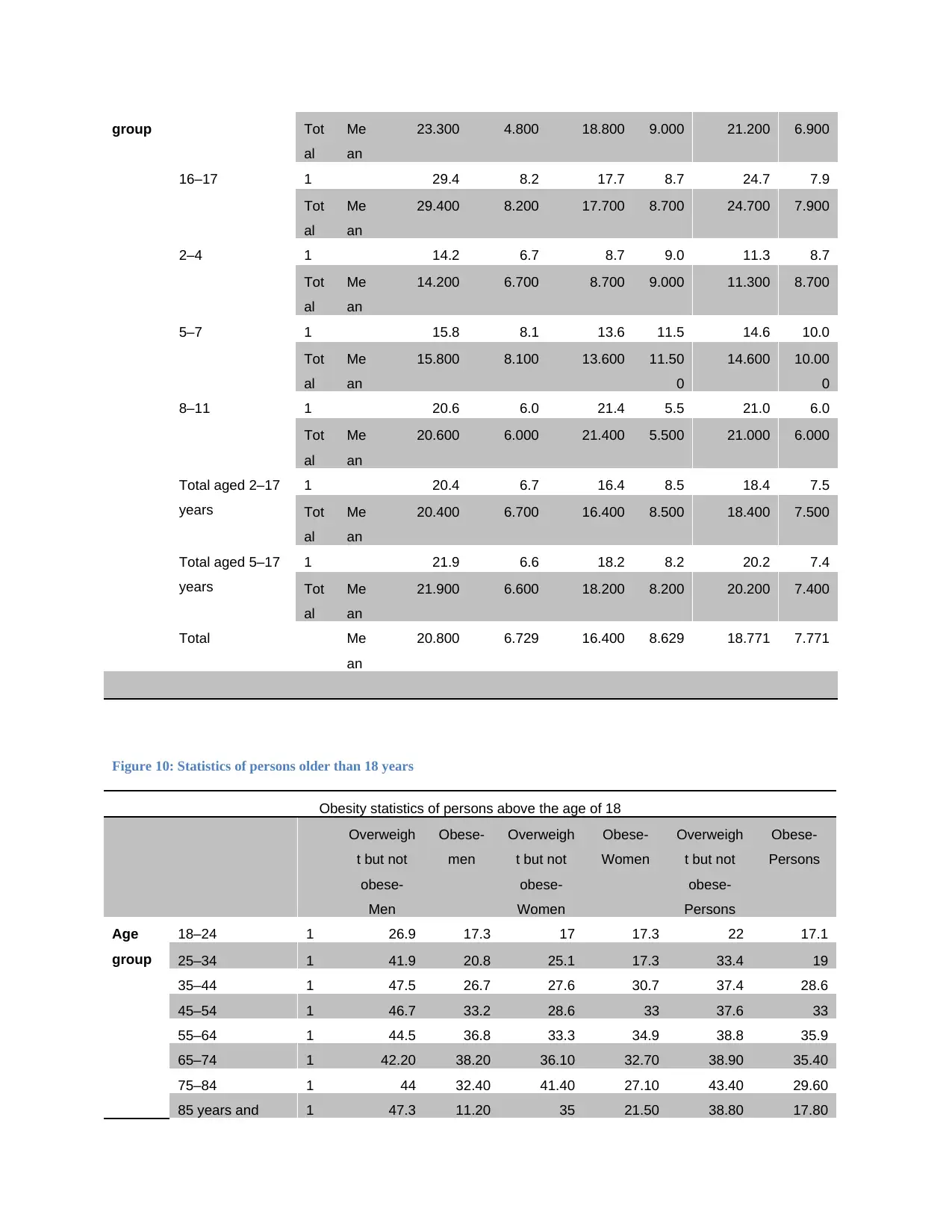
al
Me
an
23.300 4.800 18.800 9.000 21.200 6.900
16–17 1 29.4 8.2 17.7 8.7 24.7 7.9
Tot
al
Me
an
29.400 8.200 17.700 8.700 24.700 7.900
2–4 1 14.2 6.7 8.7 9.0 11.3 8.7
Tot
al
Me
an
14.200 6.700 8.700 9.000 11.300 8.700
5–7 1 15.8 8.1 13.6 11.5 14.6 10.0
Tot
al
Me
an
15.800 8.100 13.600 11.50
0
14.600 10.00
0
8–11 1 20.6 6.0 21.4 5.5 21.0 6.0
Tot
al
Me
an
20.600 6.000 21.400 5.500 21.000 6.000
Total aged 2–17
years
1 20.4 6.7 16.4 8.5 18.4 7.5
Tot
al
Me
an
20.400 6.700 16.400 8.500 18.400 7.500
Total aged 5–17
years
1 21.9 6.6 18.2 8.2 20.2 7.4
Tot
al
Me
an
21.900 6.600 18.200 8.200 20.200 7.400
Total Me
an
20.800 6.729 16.400 8.629 18.771 7.771
Figure 10: Statistics of persons older than 18 years
Obesity statistics of persons above the age of 18
Overweigh
t but not
obese-
Men
Obese-
men
Overweigh
t but not
obese-
Women
Obese-
Women
Overweigh
t but not
obese-
Persons
Obese-
Persons
Age
group
18–24 1 26.9 17.3 17 17.3 22 17.1
25–34 1 41.9 20.8 25.1 17.3 33.4 19
35–44 1 47.5 26.7 27.6 30.7 37.4 28.6
45–54 1 46.7 33.2 28.6 33 37.6 33
55–64 1 44.5 36.8 33.3 34.9 38.8 35.9
65–74 1 42.20 38.20 36.10 32.70 38.90 35.40
75–84 1 44 32.40 41.40 27.10 43.40 29.60
85 years and 1 47.3 11.20 35 21.50 38.80 17.80
Paraphrase This Document

Total 18 years
and over
1 42.4 28.4 28.8 27.4 35.5 27.9
Figure 11: Socioeconomic statistics on obesity and overweight in Australia
Statistics of obesity according to remoteness and social classes
Persons Women Men
Remoteness area Group 1 (lowest
socioeconomic group)
1 67 61 72
Total Mean 66.50 61.20 72.00
Group 2 1 65 58 73
Total Mean 65.30 57.80 73.20
Group 3 1 65 59 71
Total Mean 64.70 59.00 70.70
Group 4 1 63 56 69
Total Mean 62.60 55.50 69.40
Group 5 (highest
socioeconomic group)
1 58 48 69
Total Mean 58.00 47.70 68.60
Inner regional 1 69 63 75
Total Mean 69.20 63.30 75.40
Major cities 1 61 53 69
Total Mean 61.10 53.30 69.10
Outer regional/Remote 1 69 64 74
Total Mean 69.10 64.30 74.30
Total Mean 64.56 57.76 71.59
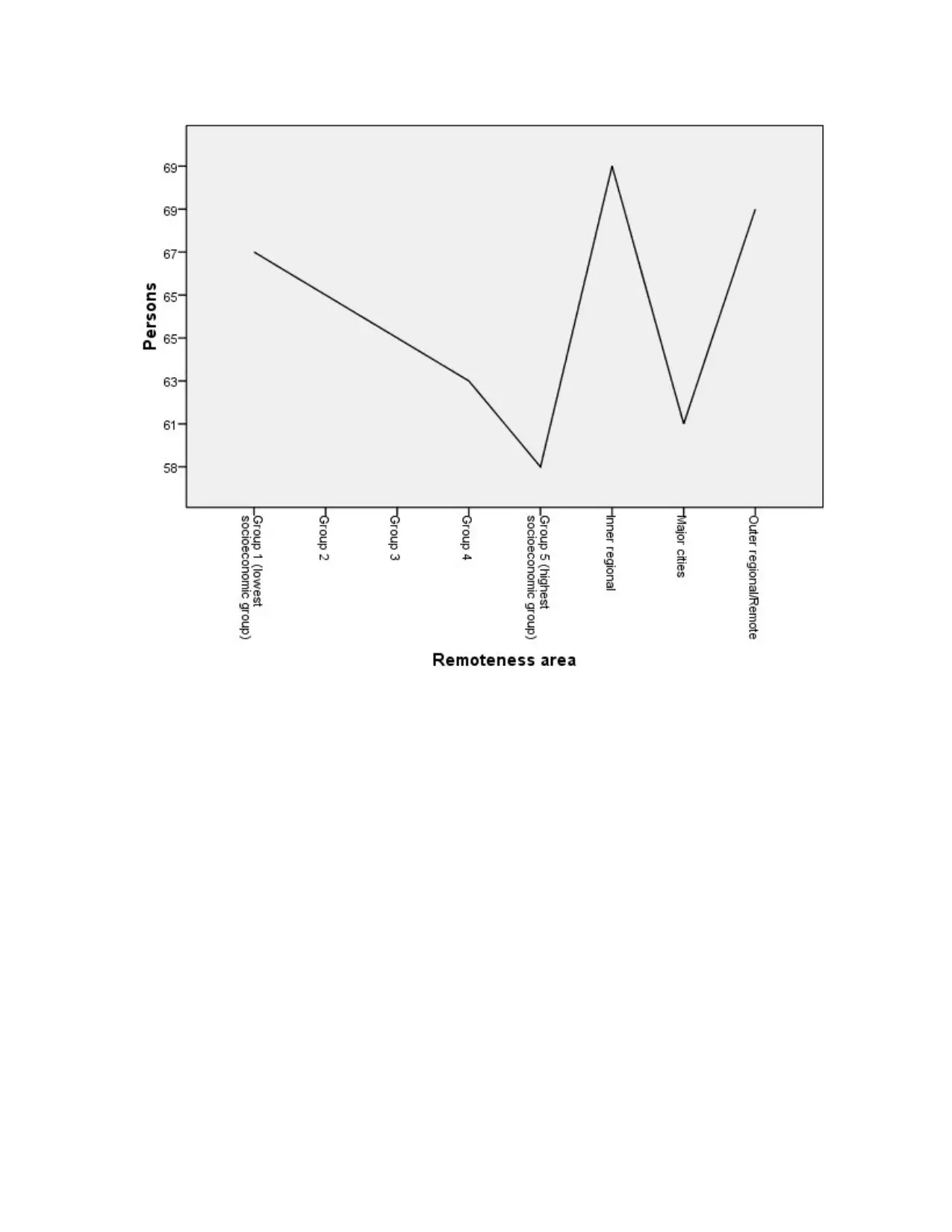
⊘ This is a preview!⊘
Do you want full access?
Subscribe today to unlock all pages.

Trusted by 1+ million students worldwide
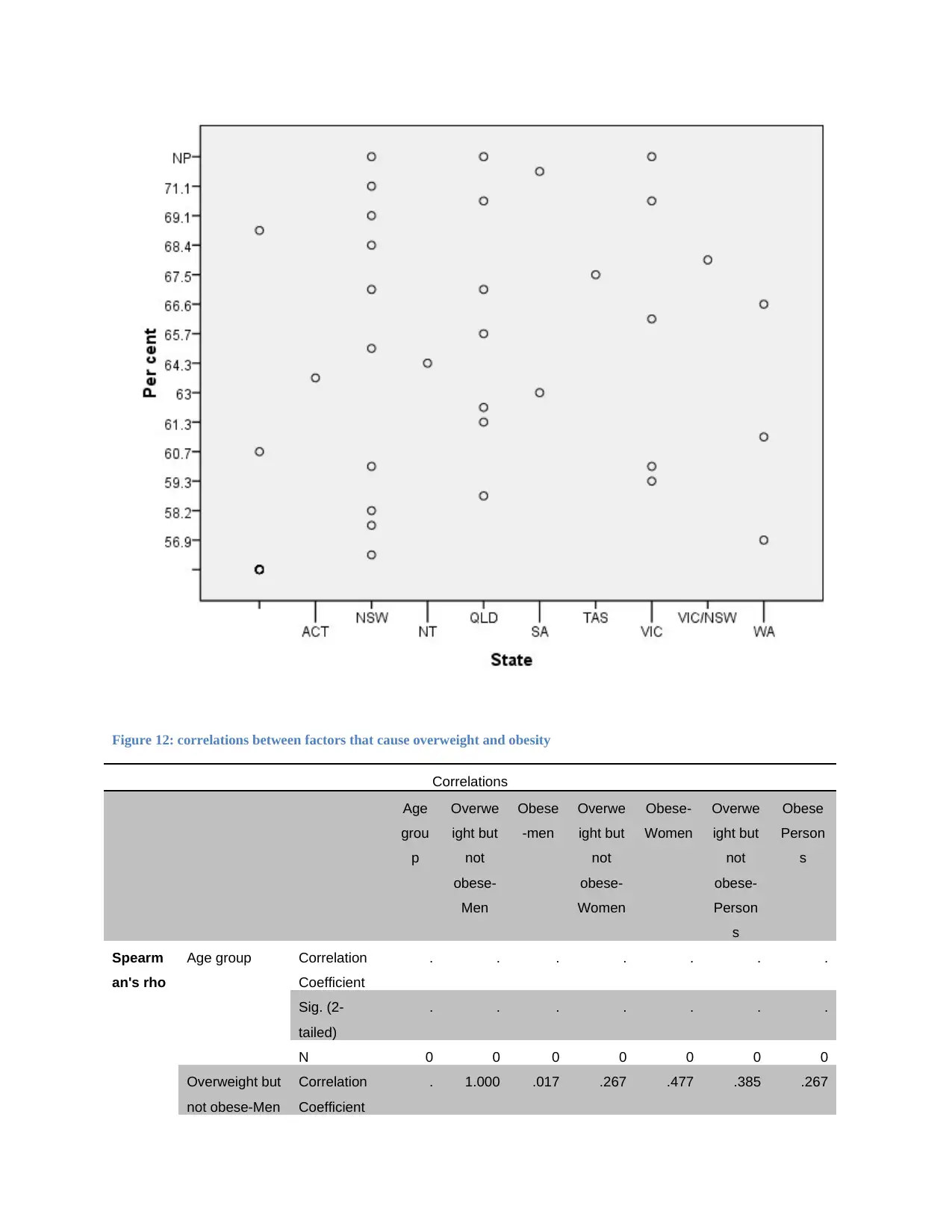
Correlations
Age
grou
p
Overwe
ight but
not
obese-
Men
Obese
-men
Overwe
ight but
not
obese-
Women
Obese-
Women
Overwe
ight but
not
obese-
Person
s
Obese
Person
s
Spearm
an's rho
Age group Correlation
Coefficient
. . . . . . .
Sig. (2-
tailed)
. . . . . . .
N 0 0 0 0 0 0 0
Overweight but
not obese-Men
Correlation
Coefficient
. 1.000 .017 .267 .477 .385 .267
Paraphrase This Document
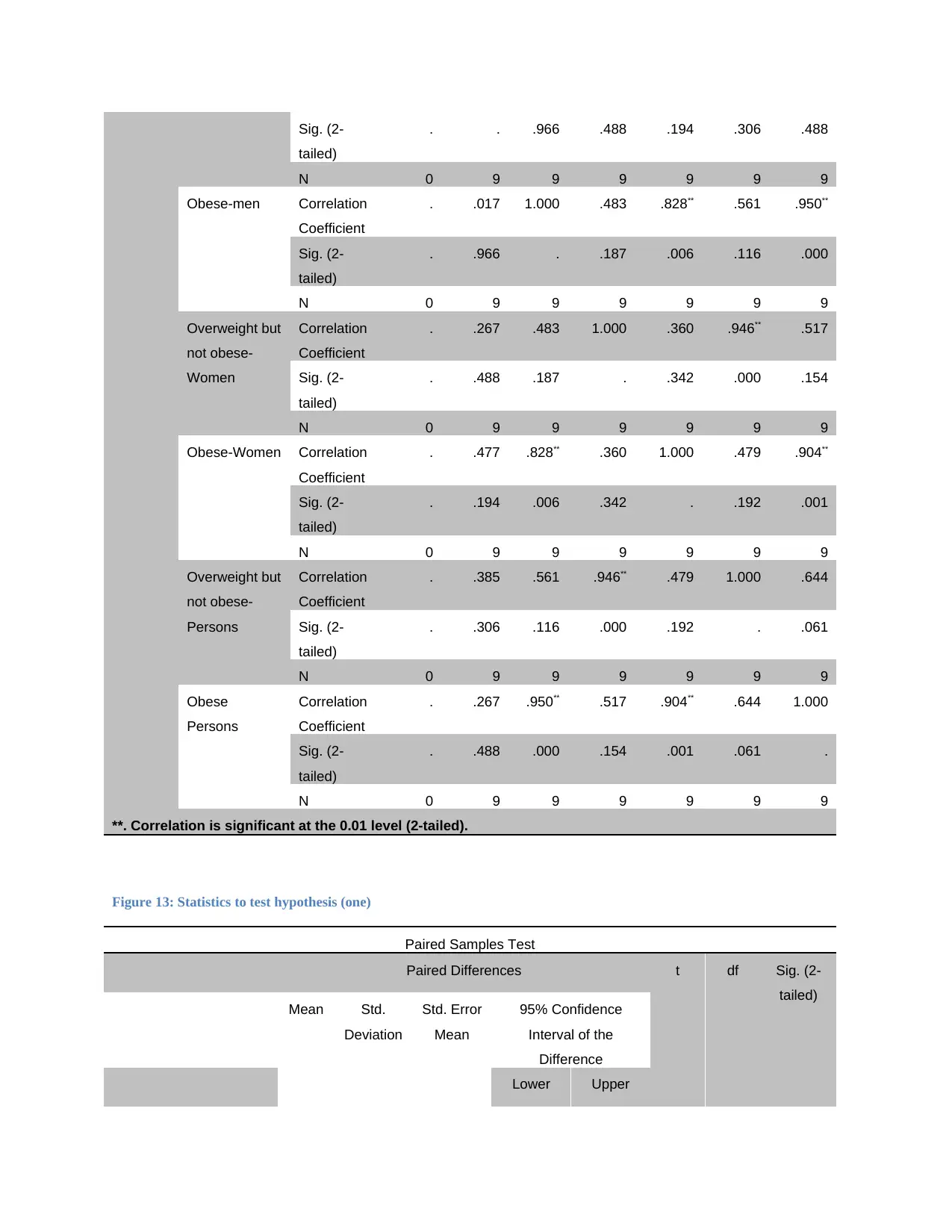
tailed)
. . .966 .488 .194 .306 .488
N 0 9 9 9 9 9 9
Obese-men Correlation
Coefficient
. .017 1.000 .483 .828** .561 .950**
Sig. (2-
tailed)
. .966 . .187 .006 .116 .000
N 0 9 9 9 9 9 9
Overweight but
not obese-
Women
Correlation
Coefficient
. .267 .483 1.000 .360 .946** .517
Sig. (2-
tailed)
. .488 .187 . .342 .000 .154
N 0 9 9 9 9 9 9
Obese-Women Correlation
Coefficient
. .477 .828** .360 1.000 .479 .904**
Sig. (2-
tailed)
. .194 .006 .342 . .192 .001
N 0 9 9 9 9 9 9
Overweight but
not obese-
Persons
Correlation
Coefficient
. .385 .561 .946** .479 1.000 .644
Sig. (2-
tailed)
. .306 .116 .000 .192 . .061
N 0 9 9 9 9 9 9
Obese
Persons
Correlation
Coefficient
. .267 .950** .517 .904** .644 1.000
Sig. (2-
tailed)
. .488 .000 .154 .001 .061 .
N 0 9 9 9 9 9 9
**. Correlation is significant at the 0.01 level (2-tailed).
Figure 13: Statistics to test hypothesis (one)
Paired Samples Test
Paired Differences t df Sig. (2-
tailed)
Mean Std.
Deviation
Std. Error
Mean
95% Confidence
Interval of the
Difference
Lower Upper
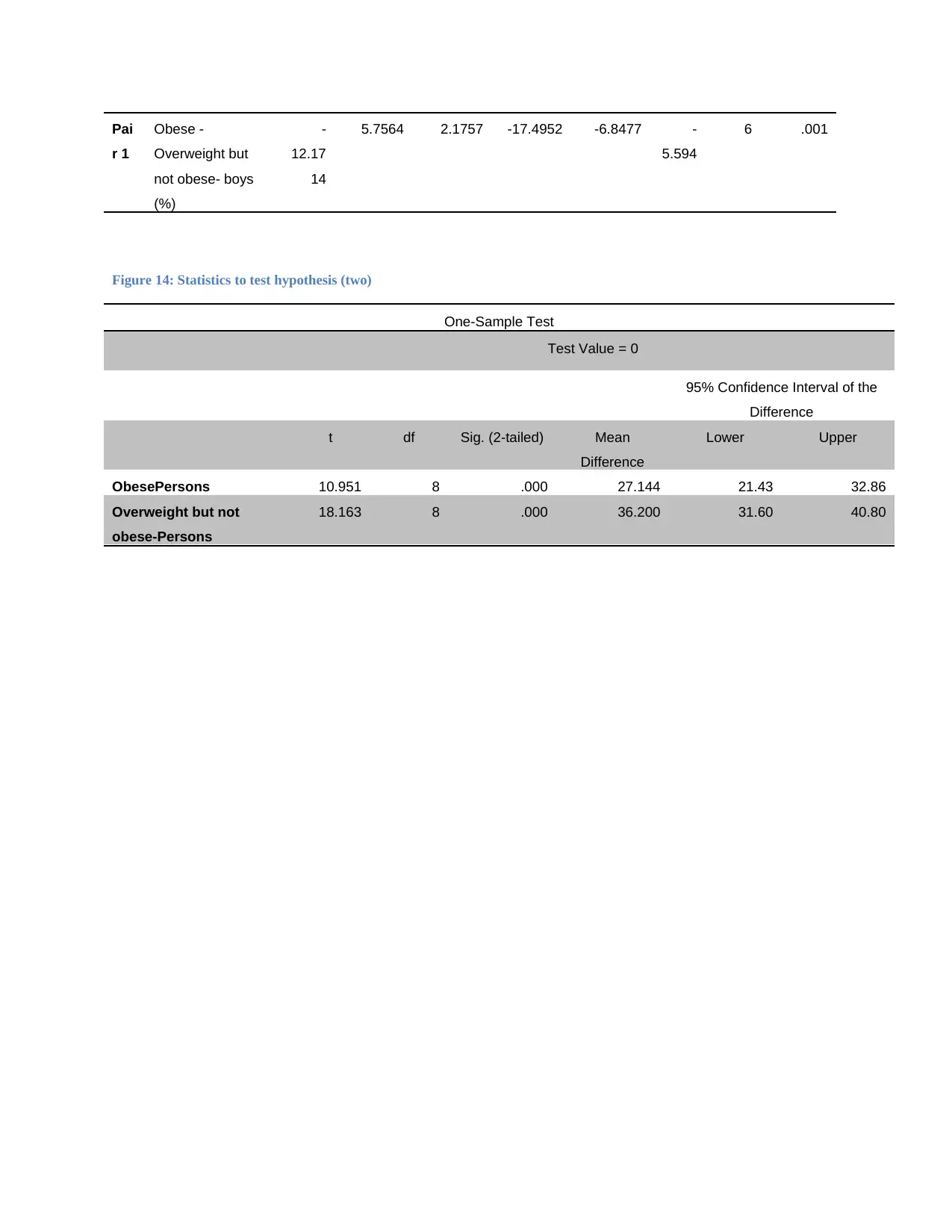
r 1
Obese -
Overweight but
not obese- boys
(%)
-
12.17
14
5.7564 2.1757 -17.4952 -6.8477 -
5.594
6 .001
Figure 14: Statistics to test hypothesis (two)
One-Sample Test
Test Value = 0
95% Confidence Interval of the
Difference
t df Sig. (2-tailed) Mean
Difference
Lower Upper
ObesePersons 10.951 8 .000 27.144 21.43 32.86
Overweight but not
obese-Persons
18.163 8 .000 36.200 31.60 40.80
⊘ This is a preview!⊘
Do you want full access?
Subscribe today to unlock all pages.

Trusted by 1+ million students worldwide
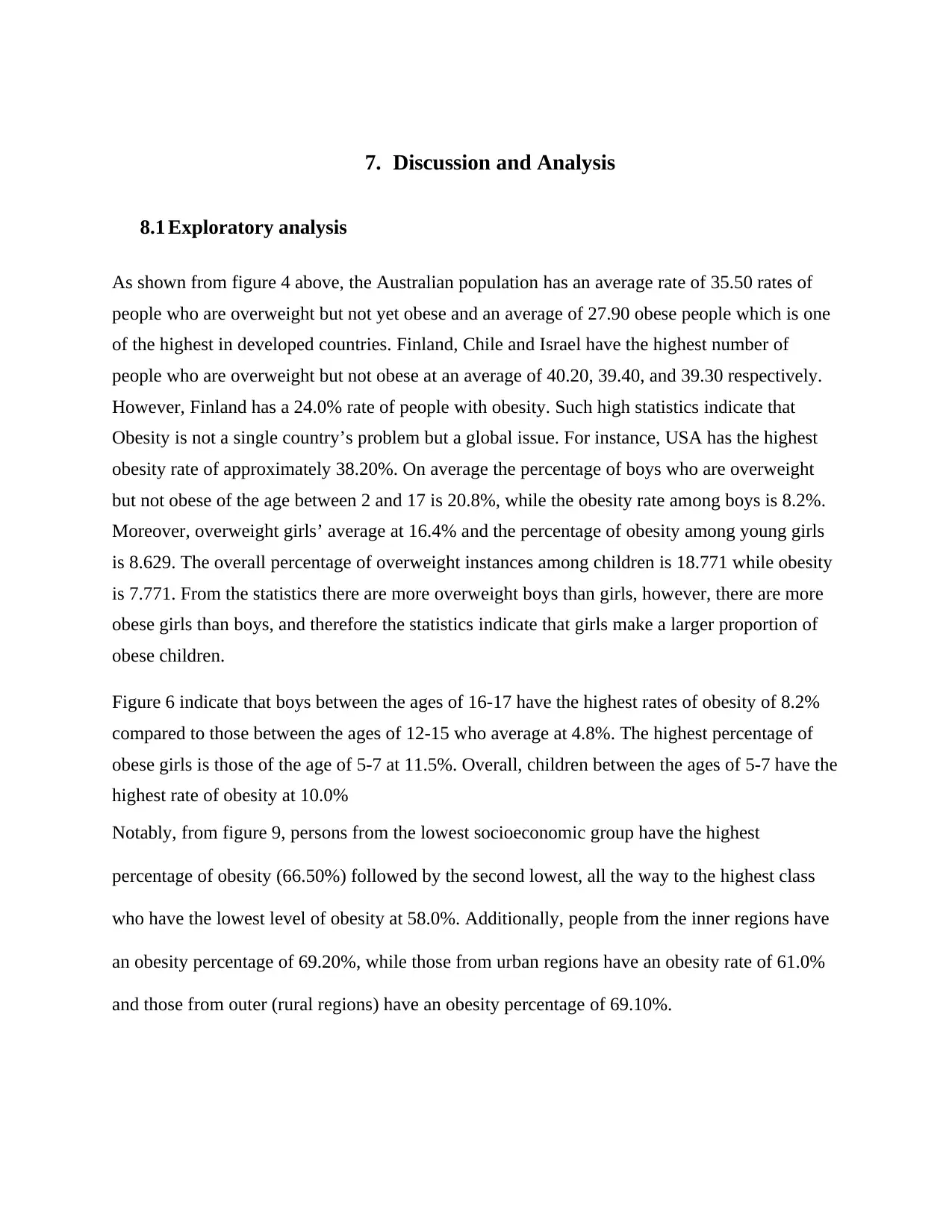
8.1 Exploratory analysis
As shown from figure 4 above, the Australian population has an average rate of 35.50 rates of
people who are overweight but not yet obese and an average of 27.90 obese people which is one
of the highest in developed countries. Finland, Chile and Israel have the highest number of
people who are overweight but not obese at an average of 40.20, 39.40, and 39.30 respectively.
However, Finland has a 24.0% rate of people with obesity. Such high statistics indicate that
Obesity is not a single country’s problem but a global issue. For instance, USA has the highest
obesity rate of approximately 38.20%. On average the percentage of boys who are overweight
but not obese of the age between 2 and 17 is 20.8%, while the obesity rate among boys is 8.2%.
Moreover, overweight girls’ average at 16.4% and the percentage of obesity among young girls
is 8.629. The overall percentage of overweight instances among children is 18.771 while obesity
is 7.771. From the statistics there are more overweight boys than girls, however, there are more
obese girls than boys, and therefore the statistics indicate that girls make a larger proportion of
obese children.
Figure 6 indicate that boys between the ages of 16-17 have the highest rates of obesity of 8.2%
compared to those between the ages of 12-15 who average at 4.8%. The highest percentage of
obese girls is those of the age of 5-7 at 11.5%. Overall, children between the ages of 5-7 have the
highest rate of obesity at 10.0%
Notably, from figure 9, persons from the lowest socioeconomic group have the highest
percentage of obesity (66.50%) followed by the second lowest, all the way to the highest class
who have the lowest level of obesity at 58.0%. Additionally, people from the inner regions have
an obesity percentage of 69.20%, while those from urban regions have an obesity rate of 61.0%
and those from outer (rural regions) have an obesity percentage of 69.10%.
Paraphrase This Document

In testing whether factors such as overweight does lead to obesity among children the null
hypothesis of whether there exists statistical evidence to conclude that overweight instances in
children lead to obesity at a significance level of 5% is used. The p-value is 0.001 which is less
than 0.005. We fail to reject the null hypothesis and conclude that if a child is overweight, there
are chances that they may eventually be obese. Moreover, the rate of obesity between urban and
rural areas (inner regions) as well as outer regions is statistically different following a difference
in distribution of obesity percentage between urban regions, rural areas and outer regions. We
therefore reject the second null hypothesis that there is no sufficient statistical evidence that the
rate of obesity between urban and rural areas is the same and conclude that there is difference in
the rates of obesity between different regions as well as socioeconomic strata.

The study contributes to the wide literature on the effects of weight issues on health, thereby
aiding raise awareness on the extent to which unmonitored weight can affect the health of
individuals. In addition, the study helps outline the various factors that are causal agents of
overweight and/ or obesity. As such, it sensitizes on the very factors that individuals ought to
avoid or concentrate on in order to ensure their BMI is on the right scale, in aim of avoiding
weight related illnesses. Lastly, the study explores the health issues such as hypertension
resulting from obesity or overweight.
⊘ This is a preview!⊘
Do you want full access?
Subscribe today to unlock all pages.

Trusted by 1+ million students worldwide
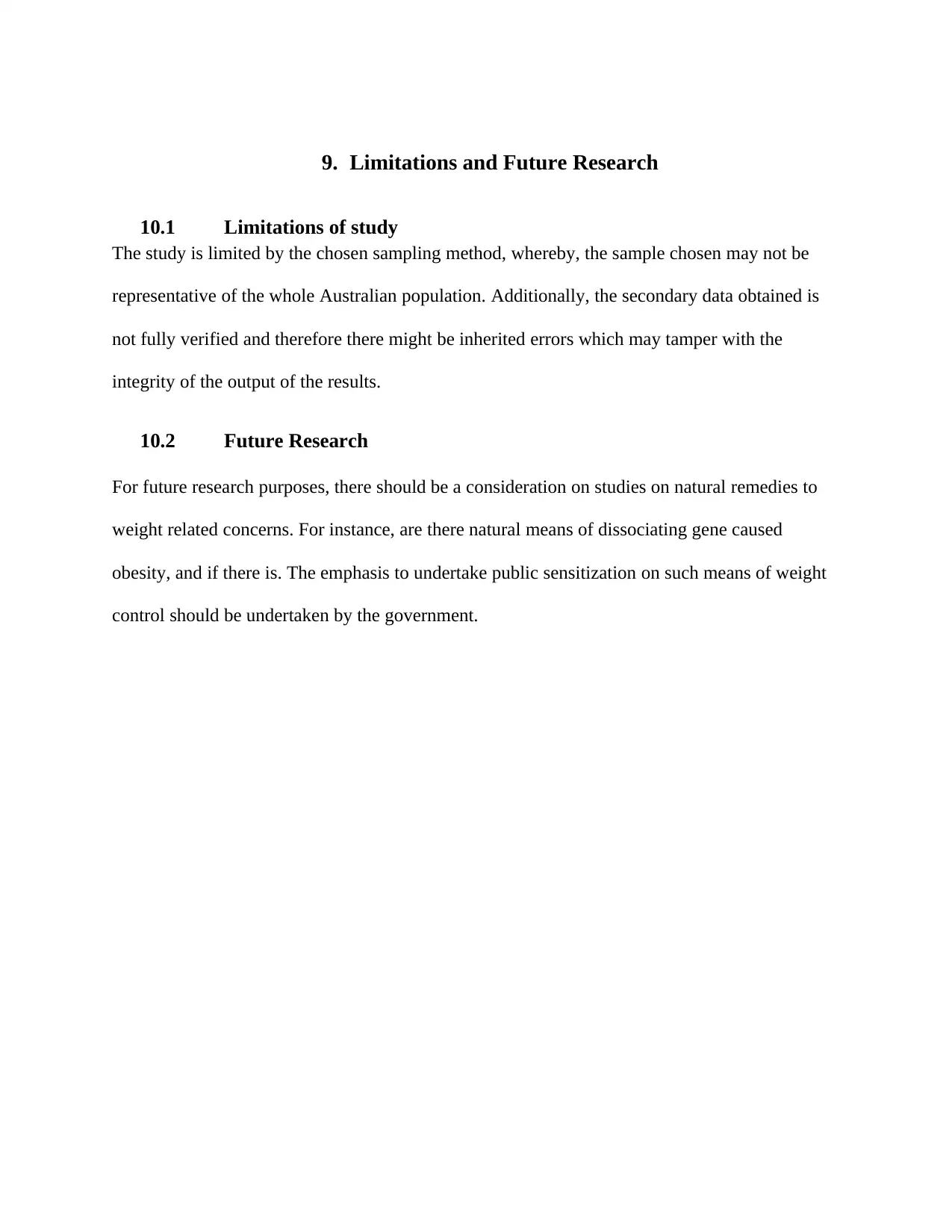
10.1 Limitations of study
The study is limited by the chosen sampling method, whereby, the sample chosen may not be
representative of the whole Australian population. Additionally, the secondary data obtained is
not fully verified and therefore there might be inherited errors which may tamper with the
integrity of the output of the results.
10.2 Future Research
For future research purposes, there should be a consideration on studies on natural remedies to
weight related concerns. For instance, are there natural means of dissociating gene caused
obesity, and if there is. The emphasis to undertake public sensitization on such means of weight
control should be undertaken by the government.
Paraphrase This Document
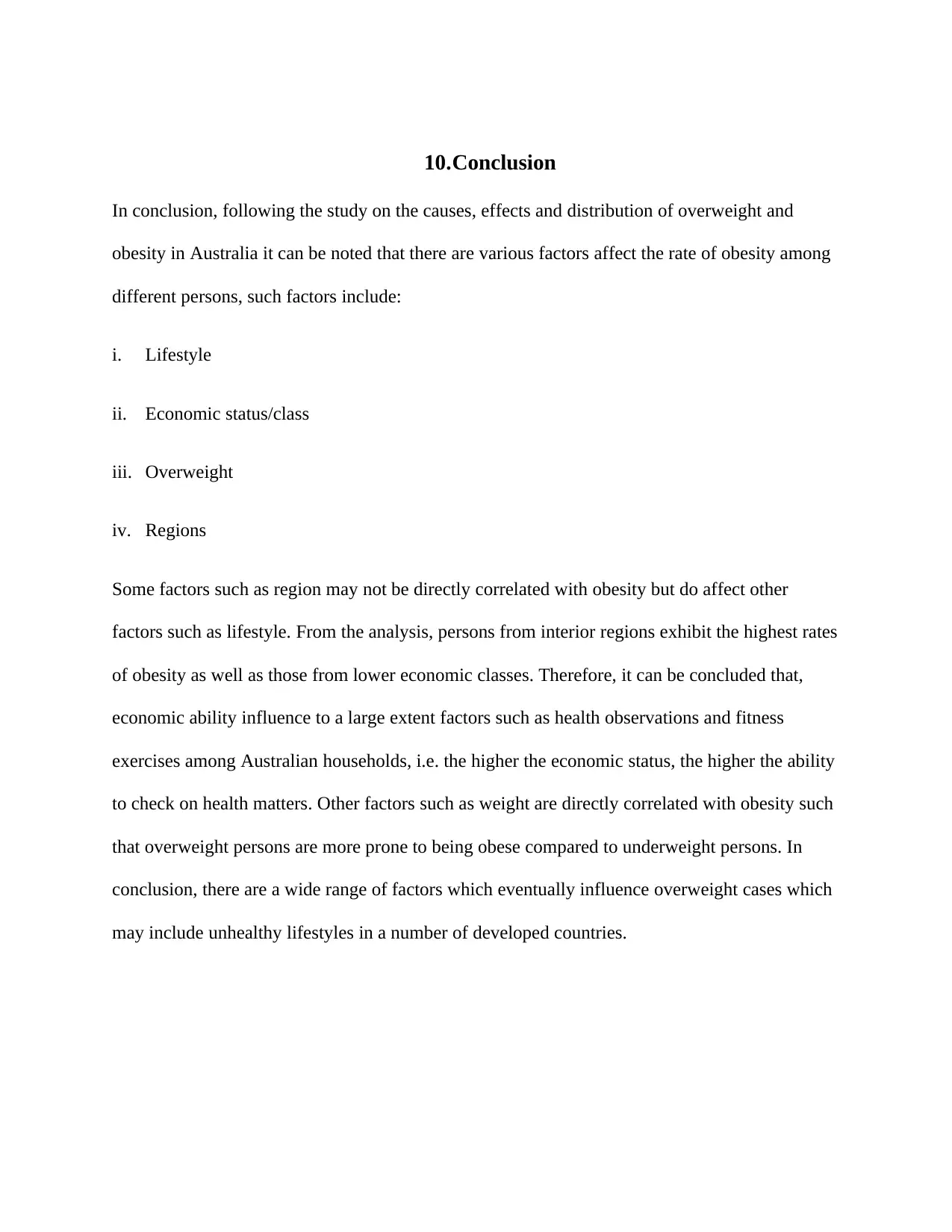
In conclusion, following the study on the causes, effects and distribution of overweight and
obesity in Australia it can be noted that there are various factors affect the rate of obesity among
different persons, such factors include:
i. Lifestyle
ii. Economic status/class
iii. Overweight
iv. Regions
Some factors such as region may not be directly correlated with obesity but do affect other
factors such as lifestyle. From the analysis, persons from interior regions exhibit the highest rates
of obesity as well as those from lower economic classes. Therefore, it can be concluded that,
economic ability influence to a large extent factors such as health observations and fitness
exercises among Australian households, i.e. the higher the economic status, the higher the ability
to check on health matters. Other factors such as weight are directly correlated with obesity such
that overweight persons are more prone to being obese compared to underweight persons. In
conclusion, there are a wide range of factors which eventually influence overweight cases which
may include unhealthy lifestyles in a number of developed countries.
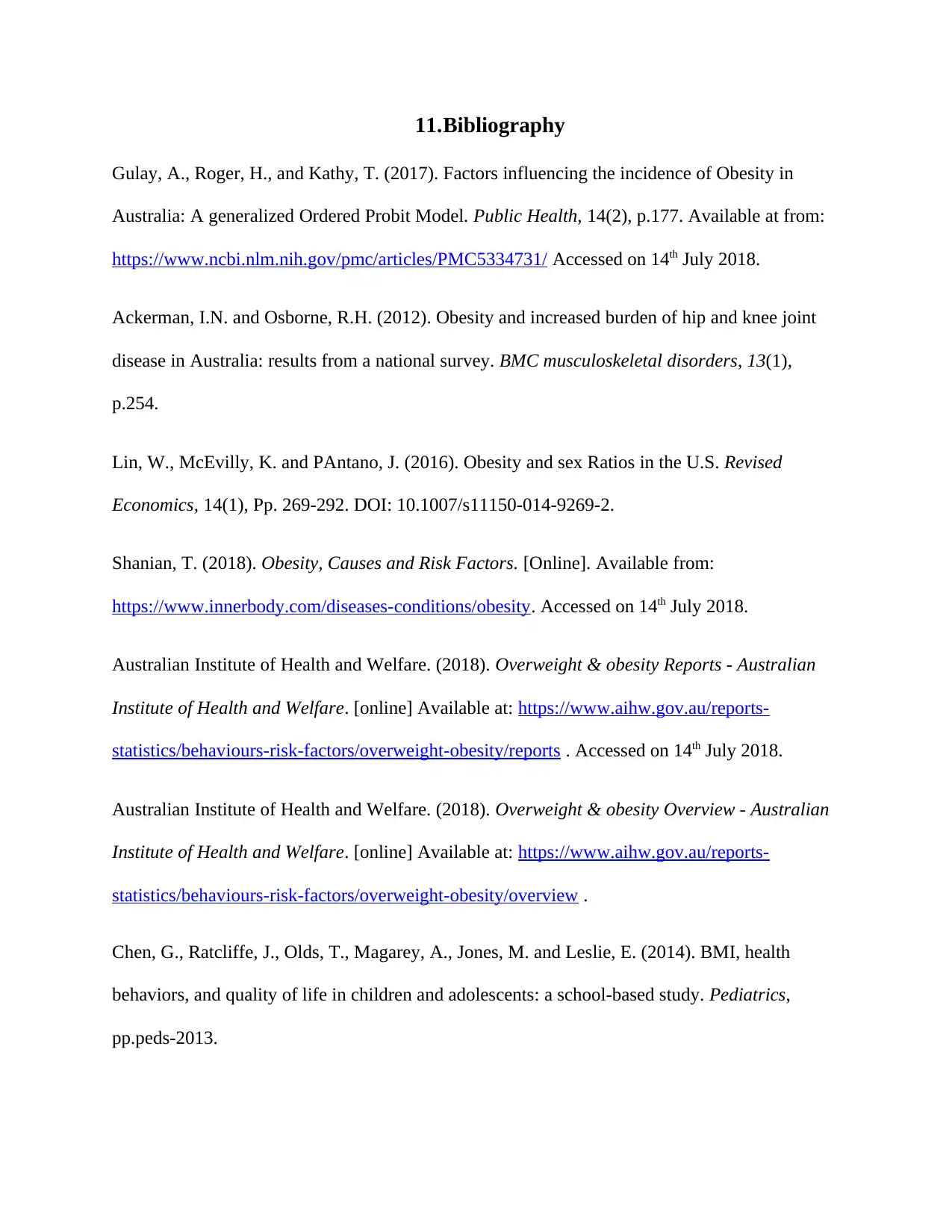
Gulay, A., Roger, H., and Kathy, T. (2017). Factors influencing the incidence of Obesity in
Australia: A generalized Ordered Probit Model. Public Health, 14(2), p.177. Available at from:
https://www.ncbi.nlm.nih.gov/pmc/articles/PMC5334731/ Accessed on 14th July 2018.
Ackerman, I.N. and Osborne, R.H. (2012). Obesity and increased burden of hip and knee joint
disease in Australia: results from a national survey. BMC musculoskeletal disorders, 13(1),
p.254.
Lin, W., McEvilly, K. and PAntano, J. (2016). Obesity and sex Ratios in the U.S. Revised
Economics, 14(1), Pp. 269-292. DOI: 10.1007/s11150-014-9269-2.
Shanian, T. (2018). Obesity, Causes and Risk Factors. [Online]. Available from:
https://www.innerbody.com/diseases-conditions/obesity. Accessed on 14th July 2018.
Australian Institute of Health and Welfare. (2018). Overweight & obesity Reports - Australian
Institute of Health and Welfare. [online] Available at: https://www.aihw.gov.au/reports-
statistics/behaviours-risk-factors/overweight-obesity/reports . Accessed on 14th July 2018.
Australian Institute of Health and Welfare. (2018). Overweight & obesity Overview - Australian
Institute of Health and Welfare. [online] Available at: https://www.aihw.gov.au/reports-
statistics/behaviours-risk-factors/overweight-obesity/overview .
Chen, G., Ratcliffe, J., Olds, T., Magarey, A., Jones, M. and Leslie, E. (2014). BMI, health
behaviors, and quality of life in children and adolescents: a school-based study. Pediatrics,
pp.peds-2013.
⊘ This is a preview!⊘
Do you want full access?
Subscribe today to unlock all pages.

Trusted by 1+ million students worldwide
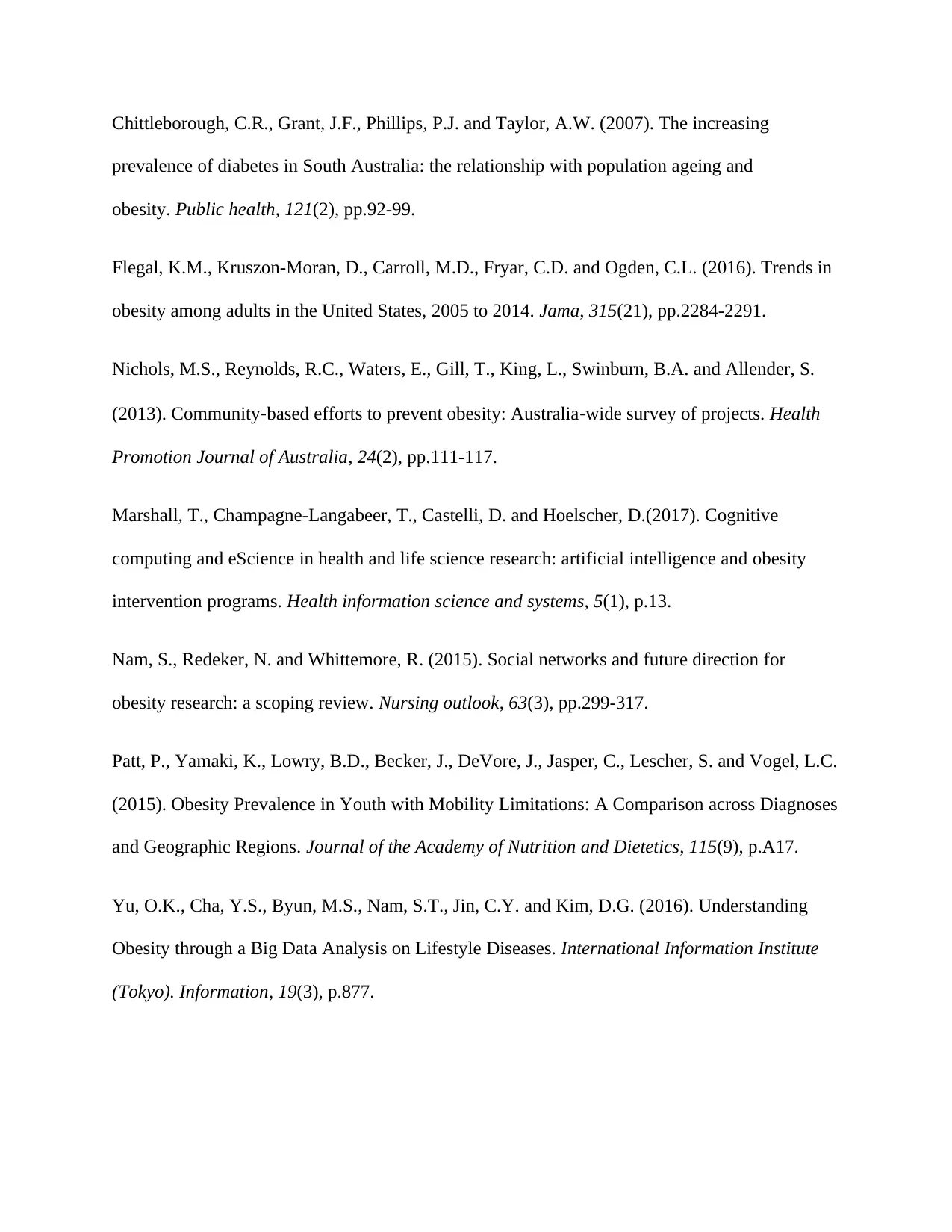
prevalence of diabetes in South Australia: the relationship with population ageing and
obesity. Public health, 121(2), pp.92-99.
Flegal, K.M., Kruszon-Moran, D., Carroll, M.D., Fryar, C.D. and Ogden, C.L. (2016). Trends in
obesity among adults in the United States, 2005 to 2014. Jama, 315(21), pp.2284-2291.
Nichols, M.S., Reynolds, R.C., Waters, E., Gill, T., King, L., Swinburn, B.A. and Allender, S.
(2013). Community‐based efforts to prevent obesity: Australia‐wide survey of projects. Health
Promotion Journal of Australia, 24(2), pp.111-117.
Marshall, T., Champagne-Langabeer, T., Castelli, D. and Hoelscher, D.(2017). Cognitive
computing and eScience in health and life science research: artificial intelligence and obesity
intervention programs. Health information science and systems, 5(1), p.13.
Nam, S., Redeker, N. and Whittemore, R. (2015). Social networks and future direction for
obesity research: a scoping review. Nursing outlook, 63(3), pp.299-317.
Patt, P., Yamaki, K., Lowry, B.D., Becker, J., DeVore, J., Jasper, C., Lescher, S. and Vogel, L.C.
(2015). Obesity Prevalence in Youth with Mobility Limitations: A Comparison across Diagnoses
and Geographic Regions. Journal of the Academy of Nutrition and Dietetics, 115(9), p.A17.
Yu, O.K., Cha, Y.S., Byun, M.S., Nam, S.T., Jin, C.Y. and Kim, D.G. (2016). Understanding
Obesity through a Big Data Analysis on Lifestyle Diseases. International Information Institute
(Tokyo). Information, 19(3), p.877.
Paraphrase This Document

1-Raw data
Remoteness area Persons Women Men
Major cities 61.1 53.3 69.1
Inner regional 69.2 63.3 75.4
Outer regional/Remote 69.1 64.3 74.3
Socioeconomic group
Group 1 (lowest socioeconomic
group) 66.5 61.2 72
Group 2 65.3 57.8 73.2
Group 3 64.7 59 70.7
Group 4 62.6 55.5 69.4
Group 5 (highest socioeconomic
group) 58 47.7 68.6
Country Overweight but not obese (%) Obese (%) Overweight or obese (%)
Australia 35.5 27.9 63.4
Belgium 32.4 18.6 51
Canada 34.5 25.8 60.3
Chile 39.4 25.1 64.5
Czech Republic 34 21 55
Estonia 33.3 18 51.3
Finland 40.2 24.8 65
France 32.4 16.9 49.3
Germany 36.4 23.6 60
Hungary 32.3 30 62.3
Ireland 38 23 61
Israel 39.3 22.9 62.2
Japan 20.1 3.7 23.8
Korea 28.1 5.3 33.4
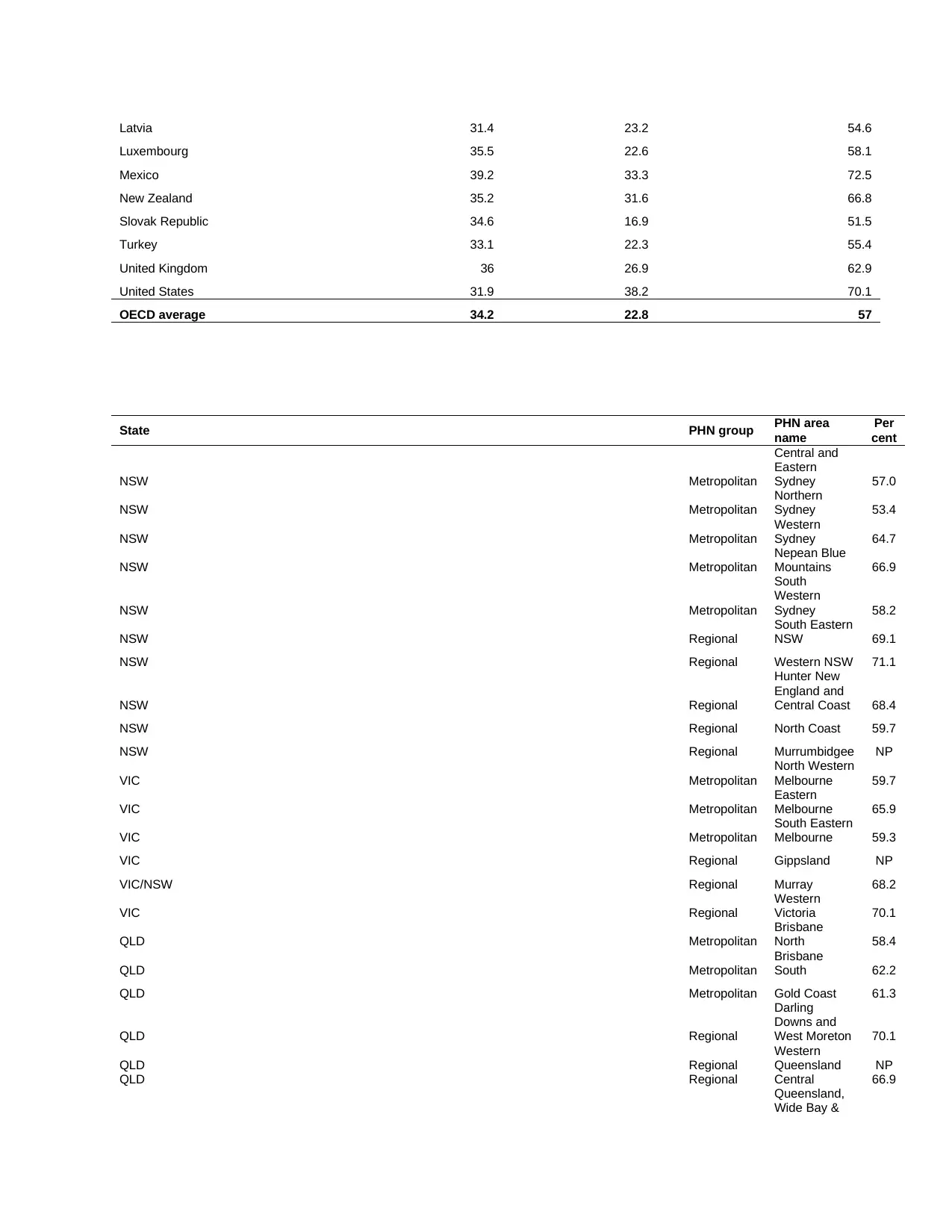
Luxembourg 35.5 22.6 58.1
Mexico 39.2 33.3 72.5
New Zealand 35.2 31.6 66.8
Slovak Republic 34.6 16.9 51.5
Turkey 33.1 22.3 55.4
United Kingdom 36 26.9 62.9
United States 31.9 38.2 70.1
OECD average 34.2 22.8 57
State PHN group PHN area
name
Per
cent
NSW Metropolitan
Central and
Eastern
Sydney 57.0
NSW Metropolitan
Northern
Sydney 53.4
NSW Metropolitan
Western
Sydney 64.7
NSW Metropolitan
Nepean Blue
Mountains 66.9
NSW Metropolitan
South
Western
Sydney 58.2
NSW Regional
South Eastern
NSW 69.1
NSW Regional Western NSW 71.1
NSW Regional
Hunter New
England and
Central Coast 68.4
NSW Regional North Coast 59.7
NSW Regional Murrumbidgee NP
VIC Metropolitan
North Western
Melbourne 59.7
VIC Metropolitan
Eastern
Melbourne 65.9
VIC Metropolitan
South Eastern
Melbourne 59.3
VIC Regional Gippsland NP
VIC/NSW Regional Murray 68.2
VIC Regional
Western
Victoria 70.1
QLD Metropolitan
Brisbane
North 58.4
QLD Metropolitan
Brisbane
South 62.2
QLD Metropolitan Gold Coast 61.3
QLD Regional
Darling
Downs and
West Moreton 70.1
QLD Regional
Western
Queensland NP
QLD Regional Central
Queensland,
Wide Bay &
66.9
⊘ This is a preview!⊘
Do you want full access?
Subscribe today to unlock all pages.

Trusted by 1+ million students worldwide

Coast
QLD Regional
Northern
Queensland 65.7
SA Metropolitan Adelaide 63.0
SA Regional Country SA 73.3
WA Metropolitan Perth North 56.9
WA Metropolitan Perth South 61.0
WA Regional Country WA 66.6
TAS Regional Tasmania 67.5
NT Regional
Northern
Territory* 64.3
ACT Metropolitan
Australian
Capital
Territory 63.5
60.7
68.5
Age group Overweight but not obese-Men Obese-men
Paraphrase This Document

25–34 41.9 20.8
35–44 47.5 26.7
45–54 46.7 33.2
55–64 44.5 36.8
65–74 42.2 38.2
75–84 44 32.4
85 years and over 47.3 11.2
Total 18 years and over 42.4 28.4
Remoteness area Persons Women Men
Major cities 61.1 53.3 69.1
Inner regional 69.2 63.3 75.4
Outer regional/Remote 69.1 64.3 74.3
Socioeconomic group
Group 1 (lowest socioeconomic
group) 66.5 61.2 72
Group 2 65.3 57.8 73.2
Group 3 64.7 59 70.7
Group 4 62.6 55.5 69.4
Group 5 (highest socioeconomic
group) 58 47.7 68.6
Details of secondary Research
The following were the references from which the secondary data was developed from prior to
download for data analysis for research purposes from the ministry of health database website:
ABS (Australian Bureau of Statistics) 2013. Microdata: National Nutrition Survey, 1995,
basic confidentialised unit record file, DataLab. ABS cat. no. 4807.0.30.001. Canberra:
ABS. Findings based on use of ABS microdata.
ABS 2014. Microdata: Australian Health Survey, core content—risk factors and selected
health conditions, 2011–12, expanded confidentialised unit record file, DataLab. ABS
cat. no. 4324.0.55.003. Canberra: ABS. Findings based on use of ABS microdata.
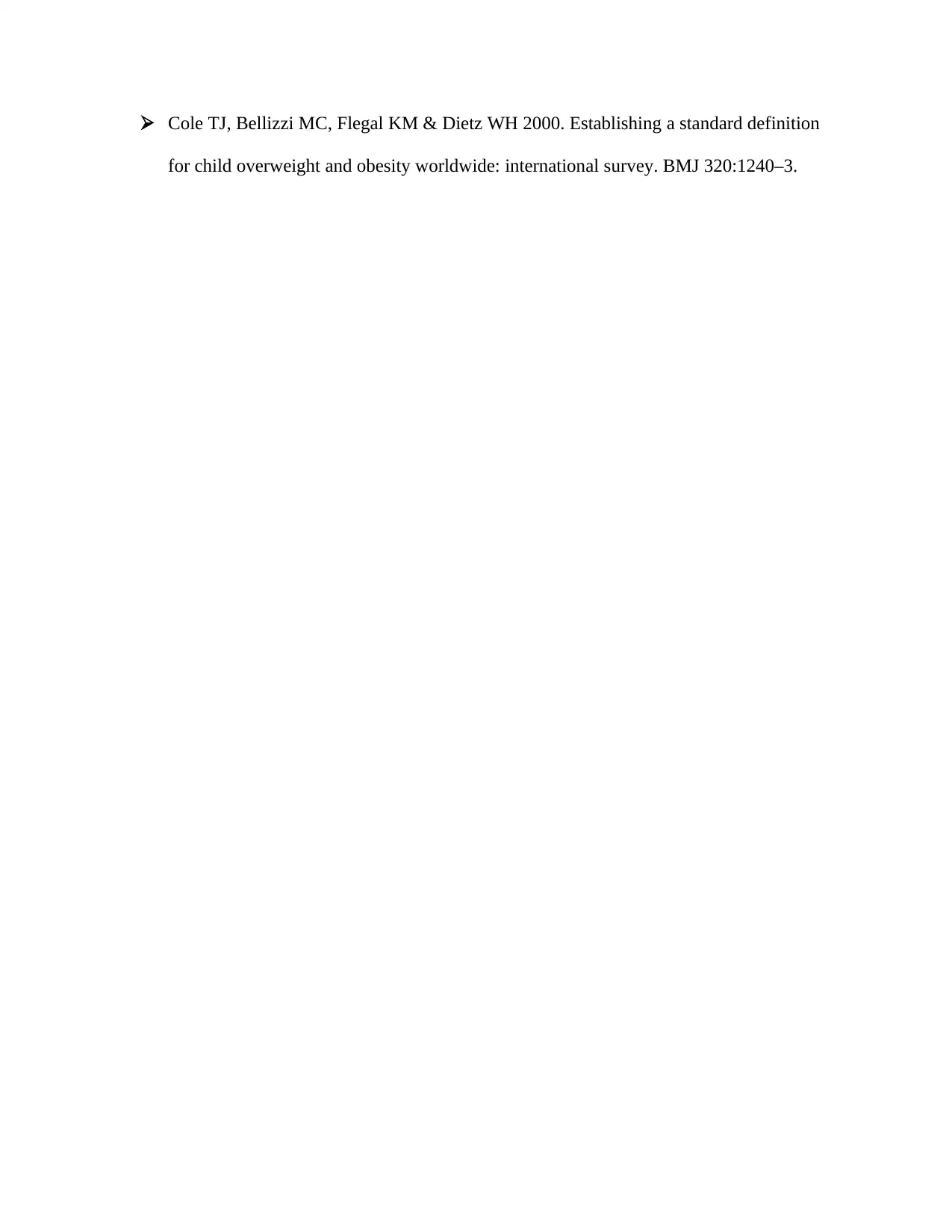
for child overweight and obesity worldwide: international survey. BMJ 320:1240–3.
⊘ This is a preview!⊘
Do you want full access?
Subscribe today to unlock all pages.

Trusted by 1+ million students worldwide
Related Documents
Your All-in-One AI-Powered Toolkit for Academic Success.
+13062052269
info@desklib.com
Available 24*7 on WhatsApp / Email
![[object Object]](/_next/static/media/star-bottom.7253800d.svg)
© 2024 | Zucol Services PVT LTD | All rights reserved.





